As our two years in India come to an end, I have struggled with how to communicate what the time has meant to me and what I have learned about myself and the world around me. I think I need to get some time between me and some of my experiences here to really be able to articulate what I have learned about myself. It might be that I never want to put those things down for posterity; maybe I should leave them to philosophy beers and the cone of silence around a sailboat. It all feels so personal.
That leaves what I have learned about the world. Those who know me know I have opinions. A lot of them. Opinions that are at once closely held and open to incorporating new perspectives, and did I ever get exposed to a variety of perspectives. We were exposed to profound cultural experiences through our friend Kaveri’s company CultureRings. We had new experiences around Bangalore with Five Oceans, another of Kaveri’s projects with another friend Neha. I asked annoying questions of my Indian colleagues who never acted annoyed but answered generously and honestly. And we tried to observe and ask questions about what we were seeing. We tried to talk to as many people from as wide of a variety of positions in life as we could while assuming (an easy assumption to make) that we knew nothing about what was really at work around us. I am no cultural anthropologist like Kaveri, but I know enough about sciences, both social and otherwise, to know that what we have gathered is far from a reliable sampling, so any observations and conclusions I might write here would be way to lightly informed.
So I thought I’d stick to the books that I read. I tried to read as many books about India as I could that helped explain what we were experiencing and what people were telling us. What follows is not meant to be particularly profound, just some book reports that connect to my experiences and how the books helped inform my understanding of this amazing country.
The Hindus: An Alternative History, by Wendy Doniger.
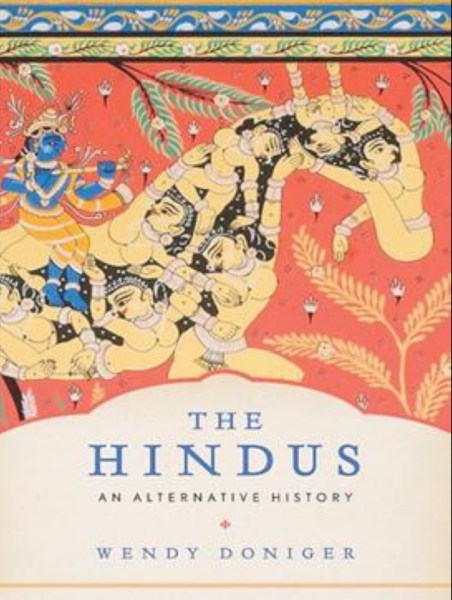 Hinduism is a far more complex faith than I ever imagined, even taking into account that it is a religion involving thousands of gods. Doniger’s central thesis is that any explanation of Hinduism depends on whom you ask. There are a few central tenants, three primary gods, and common ancient texts, but she draws a picture in her readers’ minds of what she calls the “Zen Diagram,” a play on a venn diagram made up of countless circles, all interlocking with each other but with no central connecting piece on which all circles agree. When the monolithic Christianity, Islam, and Buddhism started to make inroads in what became India, the many branches of Hinduism came together into what the rest of the world now sees as a unified faith.
Hinduism is a far more complex faith than I ever imagined, even taking into account that it is a religion involving thousands of gods. Doniger’s central thesis is that any explanation of Hinduism depends on whom you ask. There are a few central tenants, three primary gods, and common ancient texts, but she draws a picture in her readers’ minds of what she calls the “Zen Diagram,” a play on a venn diagram made up of countless circles, all interlocking with each other but with no central connecting piece on which all circles agree. When the monolithic Christianity, Islam, and Buddhism started to make inroads in what became India, the many branches of Hinduism came together into what the rest of the world now sees as a unified faith.
Much like how the Catholic Church pre-Luther used Latin to control its faithful, Brahmins (the priest and teacher caste) used Sanskrit to mold the faith into something that would maintain their influence. Doniger makes the argument that the caste system is nowhere in the ancient texts but was created by Brahmins of centuries ago in order to control the people. They then convinced people that only they were allowed to read and write Sanskrit so no one could argue otherwise. By the time people broke the stranglehold on those ancient texts, the caste system was imbedded in society to the point that it was impossible to extricate it from the social structure. Plus, the British came along and found the caste system quite convenient to create the divisions necessary for authoritarian imperialists (are there other types?) to impose their will, so it became all the more intractable.
Like the caste system, Doniger argues that many of the elements of Hinduism that tend to divide people come not from the texts or traditions but from the British. Just after we first arrived in 2017, the Supreme Court of India struck down an old colonial law that made acting on one’s homosexuality illegal. Doniger claims, as the gay rights movement has long claimed, that there is nothing Hindu about such laws, but it is another legacy of Britain’s attempt to impose their values on India. She also makes the point, even though she works very hard to make sure that hers is not a political book, that the people who support laws like it are the Hindu nationalists who hold almost all of the power right now, Hindu nationalists who claim that India is and should always be a Hindu nation rather than the pluralistic nation most of the world sees, Hindu nationalists who claim to be protecting values they attribute to Hinduism that actually come from the British. The tension between what constitutes “Hindu” or how one defines “Indian” are the root of some of the controversy surrounding The Hindus. In fact, Hindu nationalists were so unhappy with Doniger’s take that Penguin Books pulled its publication for a short time.
The primary knock against Doniger is that she is an American, not Indian, so how can she really know. As someone outside of the faith, she is able to look at the elements of the Zen Diagram for what they are without taking a side. From that purely academic perspective, she suggests that Hinduism is historically an open, progressive, and unifying faith, a notion anathema to the direction global politics are going right now.
Fundamentalists and nationalists of all parts of the world use division to prop themselves up while making the people they hope to control fear the “other”. It is true in India just as it is true in the United States and everywhere else nationalism is rearing its ugly head. Fear makes it far too easy to “other” the people around us. It takes strength and fortitude to stand up to it. Here’s hoping Americans and Indians alike can lift up the voices who are there to remind us that we actually like each other when we stop being afraid of each other.
Elephant Chaser’s Daughter, by Shilpa Raj
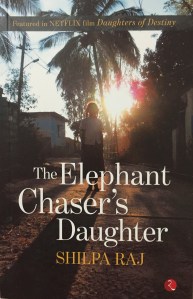 The largest group of people who have been “othered” for a long long time are the lower castes, the dalits, formerly known as “untouchables”. When one of those dalits, B.K. Ambedkar, wrote the constitution in the late 1940s with the caste system expressly written out of official Indian culture, there was hope that perhaps the divisions of the country based on the social standing of the family one was born into would no longer determine one’s future opportunities. Just as slavery and Jim Crow were outlawed a long time ago in the US but the racist social structure that persists keeps African Americans from realizing every opportunity, the caste system in India is still very much a reality, unofficial as it may be.
The largest group of people who have been “othered” for a long long time are the lower castes, the dalits, formerly known as “untouchables”. When one of those dalits, B.K. Ambedkar, wrote the constitution in the late 1940s with the caste system expressly written out of official Indian culture, there was hope that perhaps the divisions of the country based on the social standing of the family one was born into would no longer determine one’s future opportunities. Just as slavery and Jim Crow were outlawed a long time ago in the US but the racist social structure that persists keeps African Americans from realizing every opportunity, the caste system in India is still very much a reality, unofficial as it may be.
There are some efforts under way to do something about the divisions. There is a strict quota system, setting aside a number of positions in universities and many work places for “scheduled” and “backward” classes. This comes with its own stigma, however, as many Indians feel this puts these people at an unfair advantage.
Raj helps dispel that notion. She tells her own story of being born into a very poor community with very little hope for a future different from her parents, set-asides or not. At the age of 4, representatives from a brand new school, Shanti Bhavan, came to her village to interview her parents and ended up inviting her to come spend the next 14 years getting a world class education. The school was the brainchild of Abraham George, an Indian man who had struck it rich in the United States. He never lost the idea that he would do something to address the inequities in his home country. He decided to start a school specifically for children of lower caste families, providing them with an education and global perspective that would allow them to succeed to the point where they could lift up 100 other people, starting a chain reaction that might actually level the economic field.
Raj tells the story of living in two worlds. She spent most of the year at Shanti Bhavan, a protected environment with teachers and aunties who loved the children in their care and imposed expectations very different from how they lived in their villages. A few weeks every year she lived with her grandmother in her village. Her family life was complicated and rife with drama and horrible, heartbreaking moments. But they were her family, and she remained committed to them. One of the things that makes Elephant Chaser’s Daughter so riveting is Raj’s honesty. She doesn’t claim to be perfect; in fact she is unbelievably upfront about mistakes she made and people she hurt. The result is a beautiful and complete portrait of a girl trying to figure out how to make it in a world that but for this ridiculous stroke of luck was completely stacked against her.
 This is where I have to admit that I am biased. Melissa and I (mostly Melissa) have had the opportunity to meet and get to know Shilpa. She is a wonderful, gracious young woman who knows how lucky she is to have the opportunities she has and is dead set on making sure she spreads those opportunities to as many people as she can. When she spoke to a group of our very privileged kids at CIS, she enthralled them. The thing that my students told me most grabbed them comes back to Shilpa’s honesty; she truly answered their questions rather than repeating canned answers. We had the honor of going to the Shanti Bhavan graduation for one of our last weekends in Bangalore. Shilpa was a gracious host and tireless organizer. We are excited for her as she heads to Hofstra University on Long Island, New York to start her PhD program.
This is where I have to admit that I am biased. Melissa and I (mostly Melissa) have had the opportunity to meet and get to know Shilpa. She is a wonderful, gracious young woman who knows how lucky she is to have the opportunities she has and is dead set on making sure she spreads those opportunities to as many people as she can. When she spoke to a group of our very privileged kids at CIS, she enthralled them. The thing that my students told me most grabbed them comes back to Shilpa’s honesty; she truly answered their questions rather than repeating canned answers. We had the honor of going to the Shanti Bhavan graduation for one of our last weekends in Bangalore. Shilpa was a gracious host and tireless organizer. We are excited for her as she heads to Hofstra University on Long Island, New York to start her PhD program.
Judging from the kids we met and the eight classes of alumni Melissa has been working with, Dr. George’s vision is in the process of being realized. One of the things that was most impressive about our weekend at SB was that Shilpa wasn’t unique by a long shot. So many of the kids were kind and warm and laser focused on lifting their parents and their communities into a life of wider opportunity. During the graduation, Dr. George reminded them of the promise they made to lift 100 other people out of poverty when he told them, “That is not a promise you can break.” I don’t believe they needed such a strong reminder. They are on it. It is the kind of change that Dr. George is inspiring, all of those kids are committed to, and books like Shilpa’s are highlighting that is really going to make India a more equal society.
Games Indians Play, by Viswanathan Raghunathan
 A year ago I wrote about what I had learned in my first year in India. Raghunathan addresses many of the things I was having (and I still have) a hard time getting my head around. He has a particularly amusing take on the chaotic process that serves as queuing up. As an Indian who spent a significant time of his life in Europe, he asked himself why does Indian culture, a generous, outward thinking culture, have these self-destructive characteristics that allow people to push and shove and jump a queue and require a bribe and chuck garbage on the side of the street and otherwise act less than generously.
A year ago I wrote about what I had learned in my first year in India. Raghunathan addresses many of the things I was having (and I still have) a hard time getting my head around. He has a particularly amusing take on the chaotic process that serves as queuing up. As an Indian who spent a significant time of his life in Europe, he asked himself why does Indian culture, a generous, outward thinking culture, have these self-destructive characteristics that allow people to push and shove and jump a queue and require a bribe and chuck garbage on the side of the street and otherwise act less than generously.
 Raghunathan frames the question around game theory of economics, particularly the Prisoner’s Dilemma. Two suspects in a crime have the opportunity to lighten their sentence. If both suspects betray each other, they will receive two year sentences each. If I betray my partner, but my partner remains silent, I will be set free while my partner will receive a three year sentence. If both of us remain silent, we both serve one year sentences. Simple behavioral economics points to the easy answer: By remaining silent, the total number of years served in prison is either two (split between us) or three (served by only one). The worst case is both betraying each other for a grand total of four years split between us. So both should know to remain silent, right? But what if my partner doesn’t know to be silent? Then I’m screwed. Raghunathan posits that the “I’m screwed” part is primary in his fellow Indians’ decision making. Corruption makes life more difficult for all of us, but if others are doing it and I’m not, then their lives are easier and, say it with me, “I’m screwed.” If we trusted each other to do the right thing, then we could all be better off, but the right thing seems to happen so rarely that I’m going to do what’s right for me and my family right now. The negative long term consequences aren’t for me to worry about right now if ever, so I’m not going to worry about them.
Raghunathan frames the question around game theory of economics, particularly the Prisoner’s Dilemma. Two suspects in a crime have the opportunity to lighten their sentence. If both suspects betray each other, they will receive two year sentences each. If I betray my partner, but my partner remains silent, I will be set free while my partner will receive a three year sentence. If both of us remain silent, we both serve one year sentences. Simple behavioral economics points to the easy answer: By remaining silent, the total number of years served in prison is either two (split between us) or three (served by only one). The worst case is both betraying each other for a grand total of four years split between us. So both should know to remain silent, right? But what if my partner doesn’t know to be silent? Then I’m screwed. Raghunathan posits that the “I’m screwed” part is primary in his fellow Indians’ decision making. Corruption makes life more difficult for all of us, but if others are doing it and I’m not, then their lives are easier and, say it with me, “I’m screwed.” If we trusted each other to do the right thing, then we could all be better off, but the right thing seems to happen so rarely that I’m going to do what’s right for me and my family right now. The negative long term consequences aren’t for me to worry about right now if ever, so I’m not going to worry about them.
This was an interesting and frustrating read at the same time. It really did help confirm for me that some of the things I have struggled with are real and not just me, like the need to yell at people in order to get what I need. Until someone feels the pain that comes from them not doing their job, they aren’t going to worry about it. The problem with the book is that it leans a little heavy on the self-hating side, particularly since it offers no solutions. People treat strangers badly, so that’s just the way it is because no one wants to be the one to break the cycle and serve the longer sentence.
Inglorious Empire: What the British Did to India, by Sashi Tharoor
 I expected Raghunathan in Games Indians Play to at least bring the self destructive behaviors he describes back to the Raj, the period of time that Britain ruled India, because it is an easy connection to make. He doesn’t do that, though, for good and bad. It is a convenient excuse which sometimes feels like a cop out, but he also fails to look for any of the underlying causes of the acceptance of these behaviors. Tharoor, in the engaging, brilliantly written and researched book Inglorious Empire takes a different tack. He looks in detail at what the Raj did to this country while challenging Indians to see history as a way to identify the cycles at work in Indian society that need to be broken in order to go forward and not use past crimes of the Raj as an excuse. Tharoor lays a foundation for figuring out how to make India a global superpower again, but it involves coming to grips with the fact that many of the social structures that Indians hold dear are holding India back and were designed by the British to do just that.
I expected Raghunathan in Games Indians Play to at least bring the self destructive behaviors he describes back to the Raj, the period of time that Britain ruled India, because it is an easy connection to make. He doesn’t do that, though, for good and bad. It is a convenient excuse which sometimes feels like a cop out, but he also fails to look for any of the underlying causes of the acceptance of these behaviors. Tharoor, in the engaging, brilliantly written and researched book Inglorious Empire takes a different tack. He looks in detail at what the Raj did to this country while challenging Indians to see history as a way to identify the cycles at work in Indian society that need to be broken in order to go forward and not use past crimes of the Raj as an excuse. Tharoor lays a foundation for figuring out how to make India a global superpower again, but it involves coming to grips with the fact that many of the social structures that Indians hold dear are holding India back and were designed by the British to do just that.
When the East India Tea Company first set foot in what would become India, the South Asian Subcontinent accounted for 26% of the world’s economy and wealth. Today, it is somewhere in the 3% range. And this is up from 2% when Britain finally left India. How this happened was simple and simply brutal.
Indians were building ships better than anyone else in the world. British rulers didn’t like that the ships were competing with their own, so they ended production. British planters saw plentiful land to plant crops they wanted — tea and indigo among them — and tore out farms and forests in order to grow them. They did all this while taxing farmers in ways that rivalled the sharecropping system of the American Reconstruction, keeping farmers in a subservient class they would never climb out of. The result was that 60 million Indians have died in famines since the 18th century where famines simply hadn’t existed. Pre-Raj, in times of crisis the region had enough resources to support each other, but Britain refused to make the changes necessary to save lives and also refused to allow other countries to help. The latest famine was in Bihar, the state where Melissa worked, in 1966. Bihar was once the breadbasket of India and the cultural center of at least two major religions. Now it is the poorest, most desperate of Indian states thanks in large part to the Indigo plantations and what they did to the soil.
The British saw unbelievably beautiful gems and other items that symbolize the wealth they lusted after, and quite simply stole them. The most ostentatious of these thefts was the Koh-i-Noor diamond, which was “collected” from the owner as a way to pay off taxes seemingly designed to be unpayable. To make matters worse, because it didn’t live up to some Western standard of what an extravagant diamond should look like, it was re-cut, diminishing its size and some say value, and installed in to the queen’s crown, where it remains today.
Somehow, they did all this while instilling in Indians a sense of the indispensability of the Raj itself. I heard the consequences of this attitude frequently during class discussions. The English gave us a power grid. The power grid was designed by English to work well in England. Here in India, power outages are such a part of every day life, no one skips a beat when suddenly everything goes dark. If the power grid were designed by Indians, I would bet that this wouldn’t be the case — it would be designed to withstand the particular needs of this place. The English gave us trains. If Indians were building some of the world’s best ships, I’m guessing they sure could have developed a train system that would rival any in the world. Besides, the British were in such fear of Indian technological know-how, and to protect their own economic interest, they refused to allow Indians to build Indian trains — they were all built in England. The English gave us education. It is well documented that the Indian education system of rote memorization was specifically designed by the British to quash any chance of large scale Indian critical thinking which might lead Indians to wonder if the British were actually all they say they were.
The consequences of all of this can be felt everywhere today. Indian education is still very much based on the system set up by the British. Families who can afford it can send their kids to international schools like CISB, but our friend who manages a water technologies group here in Bangalore said that he has to continue to require job applicants to provide their grade 10 exam scores, so unless a student is going overseas after graduation, this actually puts them at a bit of a disadvantage.
Travelling around the country, we have seen over and over again evidence of the lie that somehow India would have fallen behind the rest of the world if not for the Raj. Indians were doing things with technology and engineering that Europeans could only dream of, from the tombs of the Mughals, the crowning achievement being the Taj Mahal, to ancient Hindu temples, this country might even have gotten out in front of these technological advances. By dismissing Indians as less-than, I truly believe the world lost out.
Which brings us back to Games Indians Play. A lot of those behaviors can be traced directly back to the behaviors encouraged by the Raj. Positions of influence were bought and sold, habits that infect any chance this country has of getting back to its position of global leadership. Corruption is everywhere, pollutes everything, and kills people. Melissa saw it in the health system in Bihar, those who interact with police see it in how they go about their daily jobs, and everyone deals with it in the political system while trying to figure out whom to support in order to move the country forward. All political parties of any influence claim to be the ones to solve the problems of corruption, but they all buy in to the corrupt system. Until the system rewards anything other than self interest, none of this is going change, people will continue to die, and this otherwise extraordinarily generous culture will only progress in fits and starts.
Behind the Beautiful Forevers, by Katherine Boo
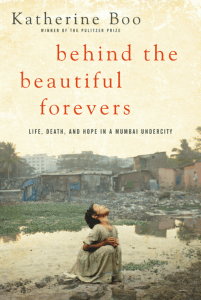 Speaking of heartbreaking and corruption seemingly designed to keep the masses down, Behind the Beautiful Forevers. Boo describes life in Annawadi, a slum near the Mumbai airport. This is a story of people simply trying to survive. They occasionally make decisions that feed the stereotypes that allow the haters to point to them and “other” them, but they are really simply trying to survive. She follows a few families over the course of a few years, painting a picture of their tiny victories that are completely swamped by their crushing everyday lives. Every hope they have that something might change is quickly extinguished by the ubiquitous corrupt self interest, from the neighbor just trying to keep her family afloat to the city planners that allow the slum to happen in the first place.
Speaking of heartbreaking and corruption seemingly designed to keep the masses down, Behind the Beautiful Forevers. Boo describes life in Annawadi, a slum near the Mumbai airport. This is a story of people simply trying to survive. They occasionally make decisions that feed the stereotypes that allow the haters to point to them and “other” them, but they are really simply trying to survive. She follows a few families over the course of a few years, painting a picture of their tiny victories that are completely swamped by their crushing everyday lives. Every hope they have that something might change is quickly extinguished by the ubiquitous corrupt self interest, from the neighbor just trying to keep her family afloat to the city planners that allow the slum to happen in the first place.
Many times this book confirmed a thought I’ve had throughout my two years in India. I want every one of my anti-regulation friends in the US to spend a month here, see what a lack of regulation looks like. In our day-to-day lives, it shows up in the pollution of every river and stream, the smog so constant it has our asthma-ridden friends fleeing the country, and garbage on every street. We see it in employers’ ability to discard their workers simply because they are afraid the workers are getting too comfortable and in the persistent poverty even when people work six twelve hour days every week. Boo describes it in the sewage pond adjacent to Annawadi, the garbage that provides the kids of the slum their illicit trade, and their fleeting brushes with reliable work.
There are efforts underway to address every single one of these issues. The lake around which I would walk every day is getting cleaner because a newly built bioswale filters out the sewage and other pollution out of one of its worst feeder streams. Businesses have requirements surrounding how many people they need to hire. There is constant talk about reducing the amount of one-time-use plastics in our daily lives. However, until the corruption issues are dealt with, there is a limit to the effect these efforts are going to have.
Read this book. It definitely has more of a universal appeal than most of the others I enjoyed these two years.
The Inheritance of Loss, by Kiran Desai
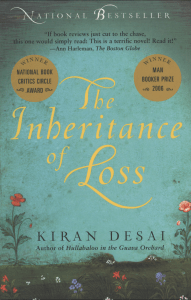 I figured I had to read at least one piece of fiction, and this was on my Kindle. How’s that for a high bar? This was an OK book. The patriarch was able to make his way up in the Indian Civil Service, a system the British put in place to curry favor with some Indians who were then treated with privilege not afforded others. Along the way he bought in to that privilege and thought pretty highly of himself. There are a few characters to cheer for — the cook, his son, the niece — whose lives are hard.
I figured I had to read at least one piece of fiction, and this was on my Kindle. How’s that for a high bar? This was an OK book. The patriarch was able to make his way up in the Indian Civil Service, a system the British put in place to curry favor with some Indians who were then treated with privilege not afforded others. Along the way he bought in to that privilege and thought pretty highly of himself. There are a few characters to cheer for — the cook, his son, the niece — whose lives are hard.
The problem I had with the book that there were just too many threads Desai was trying to weave. By the time she got back to the characters I cared most about, I didn’t care very much any more, and by the time I started caring again, she cut away to something else.
It does illuminate a couple of interesting elements of Indian life. There’s the British-oriented patriarch and the privilege to which he thinks he is entitled contrasted with the scorn or apathy with which he is treated. It is interesting to see the consequences of aligning one’s self with the British at least for one person. There is the issue of the Marxist separatists (one of the many threads that could have been an interesting stand-alone story), separatism being an issue people are dealing with now in Assam, Bengal, and Kashmir. There is the idealism with which many people think about the United States contrasted with the harsh reality of life if they are able to get there.
An Indefinite Sentence: A Personal History of Outlawed Love and Sex, by Siddharth Dube
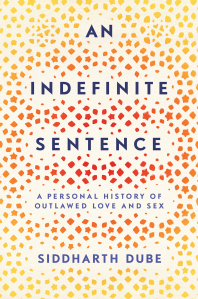 I mentioned above that soon after arriving in India, the Supreme Court overturned Section 377, the British colonial law that banned acting on one’s homosexuality. One of the first conversations I had with who became one of my most dear and trusted colleagues pointed to the silence in which the law and cultural norms around homosexuality forced our gay students to live. The confluence of these events made it a subject I was interested in but had a hard time finding the right avenue for learning. About the time a grotesque act of homophobia at school inspired a profound symposium around working to embrace all people, Dube released An Indefinite Sentence, his memoir of growing up gay in India then working in the United States, India, and several global institutions as an advocate for gay rights, for sex worker rights, and to help stem the AIDS crisis.
I mentioned above that soon after arriving in India, the Supreme Court overturned Section 377, the British colonial law that banned acting on one’s homosexuality. One of the first conversations I had with who became one of my most dear and trusted colleagues pointed to the silence in which the law and cultural norms around homosexuality forced our gay students to live. The confluence of these events made it a subject I was interested in but had a hard time finding the right avenue for learning. About the time a grotesque act of homophobia at school inspired a profound symposium around working to embrace all people, Dube released An Indefinite Sentence, his memoir of growing up gay in India then working in the United States, India, and several global institutions as an advocate for gay rights, for sex worker rights, and to help stem the AIDS crisis.
Dube tells a profound and gripping story of the evolution of his understanding of his own feelings and place in the world and the evolution of gay rights and the AIDS crisis both in the West and here in India. Sadly, none of the abuse he faced is surprising to me. Neither is the joy he feels as he reflects on the progress the world has made.
When I first started teaching and students would ask my feelings about the anti-gay ballot measures that were still making their way through Oregon politics, I would often tell them that I truly believed that by the time they were my age gay marriage would be a thing that simply happened and was celebrated, just as interracial marriage was something that happened and was celebrated. Where it was baffling to my students of the early 2000s that interracial marriage had shockingly recently been illegal, it would be baffling to their kids that gay marriage was illegal. Boy, did I call that one. It happened way faster than I ever hoped. I think India is about in that place now. Just as homophobic policy makers were making life more difficult then in the US, homophobic policy makers have a ton of control here now. Just as the youth I was working with then overwhelmingly embraced their gay classmates, most of the youth here embrace LGBTQ+ folks. There are spasms of homophobia, and the people who see their homophobic world view slipping from the mainstream get mad and loud, but they get overwhelmed by the love.
The book also brought up an important issue all Americans need to ponder, ponder hard, and then vote on. One of the most destructive elements surrounding the effort to control the AIDS epidemic in India and around the world were the policies of all American presidents from Ronald Reagan to George W. Bush. As a global superpower, and for a time the only global superpower, Americans seemed to think that in the name of helping others stem this killer, we could impose our values on them (never mind that not all Americans held those values). As a result, people died. It doesn’t matter how well-meaning people were. People died. It’s not just the abortion issue which seems to get all of the press, that the American government cannot give funds to agencies who even counsel women about the choice of abortion. Americans from Gloria Steinem to crime-and-punishment folks of all types have lived by an American-centric definition of human trafficking that has swept up desperate women who have found their only way to support their families in sex work. Human trafficking is a scourge that itself has to be solved, but not all sex workers are trafficked. By ignoring that we fail to address the underlying issues addressed in so many of the books above, that more Indians than there are total Americans live with so little hope that some of them sell their bodies.
Some notes:
- Thanks, Sandeep Thakur, for suggesting Sashi Tharoor. I accidentally read a different book than the one he suggested. I think he suggested An Era of Darkness. It also sounds good, but I don’t regret reading the one I read. Also, Sandeep is just one of the nicest humans I know, so there’s that.
- I read several other books, too, many of which were really good. These were just the books I read about India. However, I would be remiss if I didn’t celebrate my dear friend and mentor Nancy Minor’s first book Malheur August. Strong characters, lovely writing, fabulous book. Not being in Portland, I can’t say for sure, but it sounds like you can get it at Annie Bloom’s Books in Multnomah, and at Powells. You can get it at that behemoth online retailer that will remain unnamed here, too, if you aren’t near Portland. Also, by the way, Nancy is another one of those nicest people I know.
- Thanks, Melissa for being my partner in all things — adventures, mundanities, and curiosities. I would be dumber and far far less happy if you were not part of my life. Thanks for not only being yet another of the nicest people I know, but showering me with your niceness every single day, even and especially when I’m out of sorts.
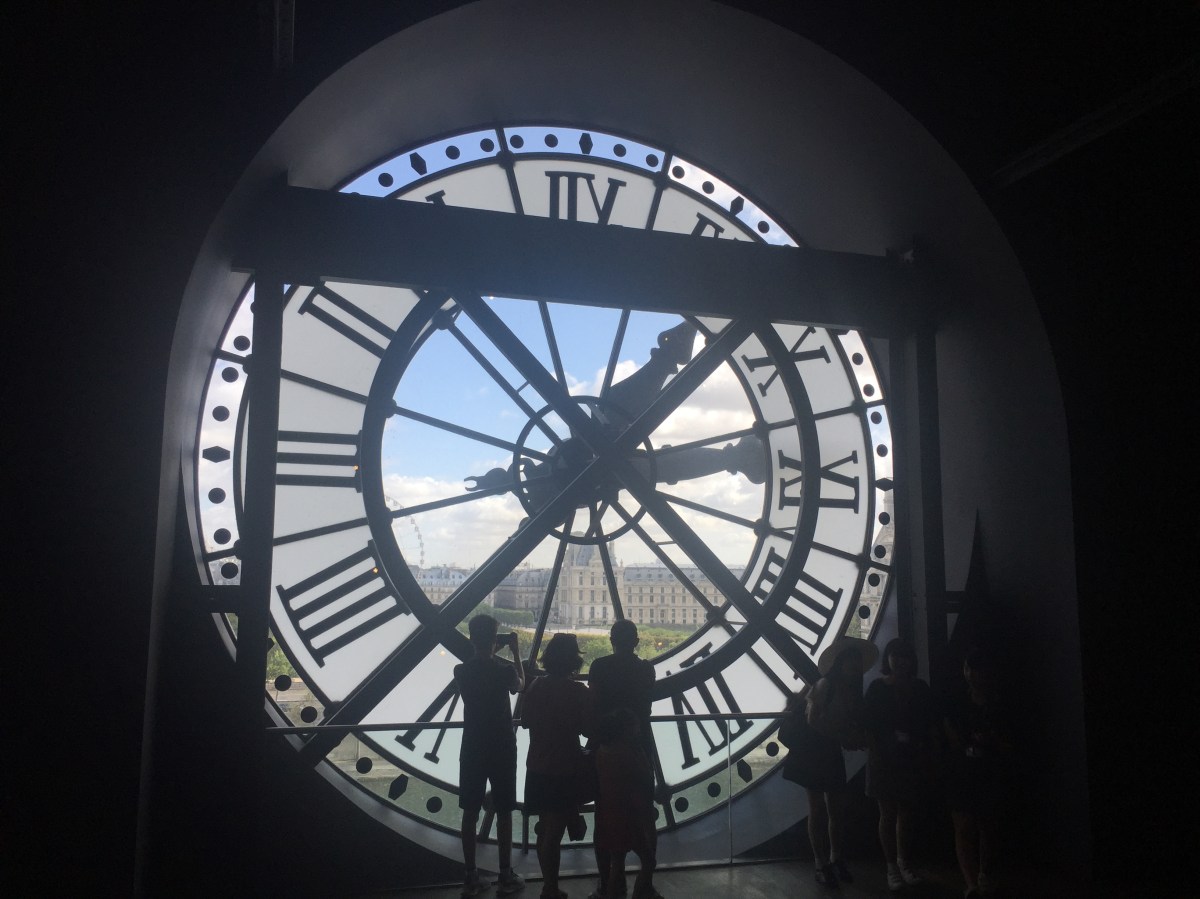


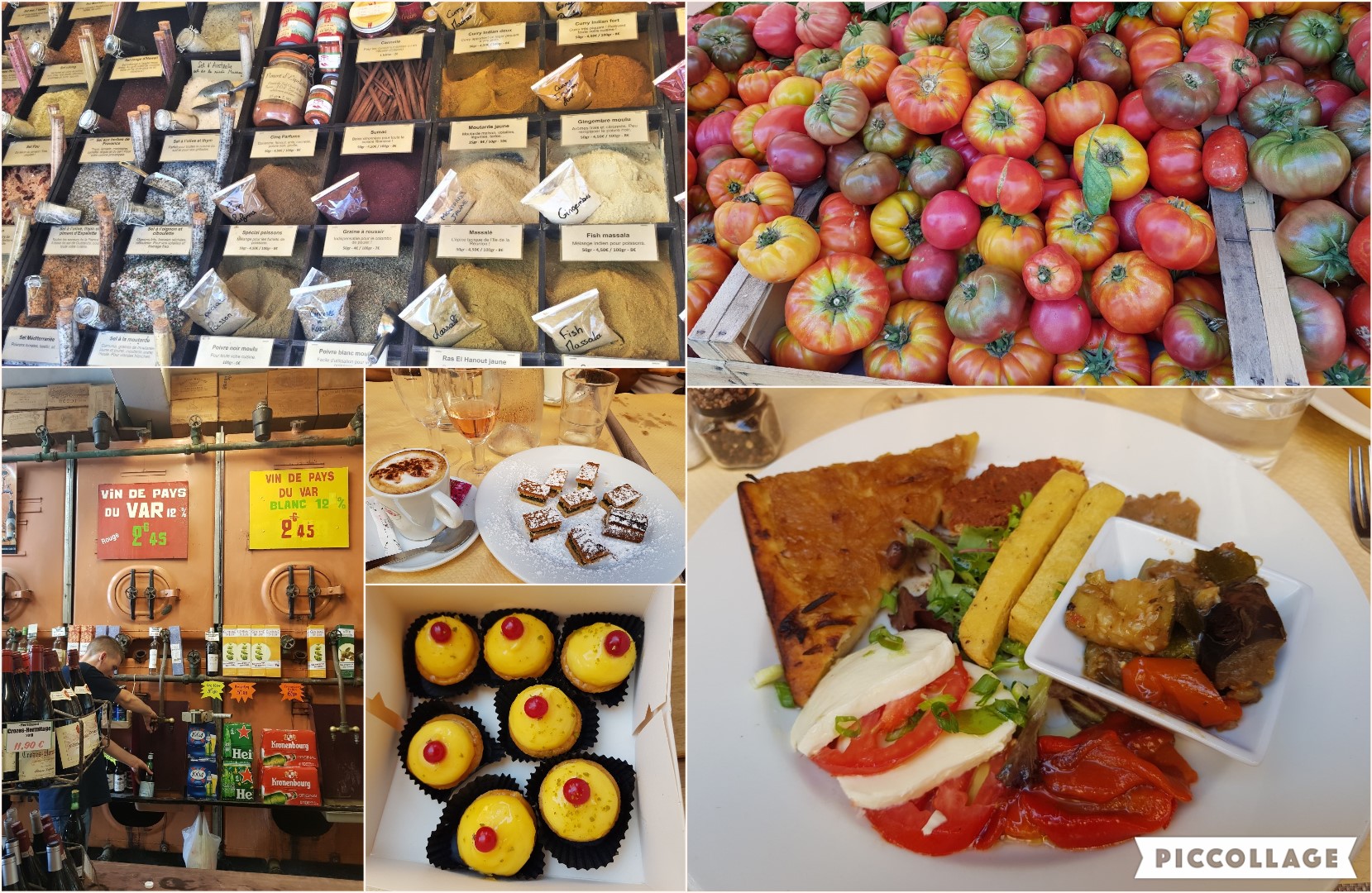
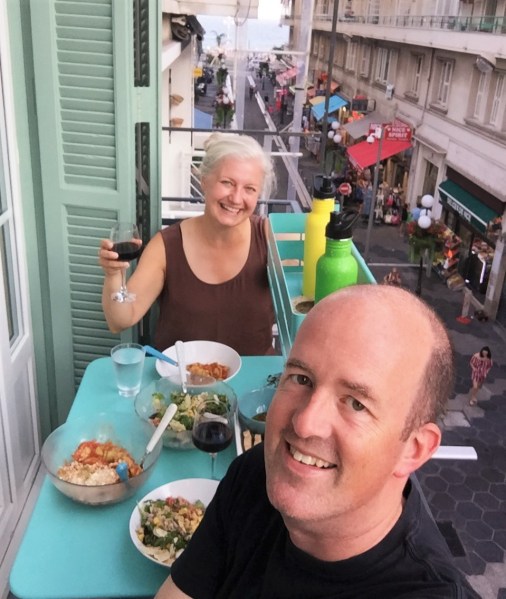 Our best meal was one we had on our tiny balcony of our Airbnb. We had a small view of the Mediterranean Sea as we dined above the tourists making their way through our little pedestrian street. We found sauce and fresh ravioli at
Our best meal was one we had on our tiny balcony of our Airbnb. We had a small view of the Mediterranean Sea as we dined above the tourists making their way through our little pedestrian street. We found sauce and fresh ravioli at 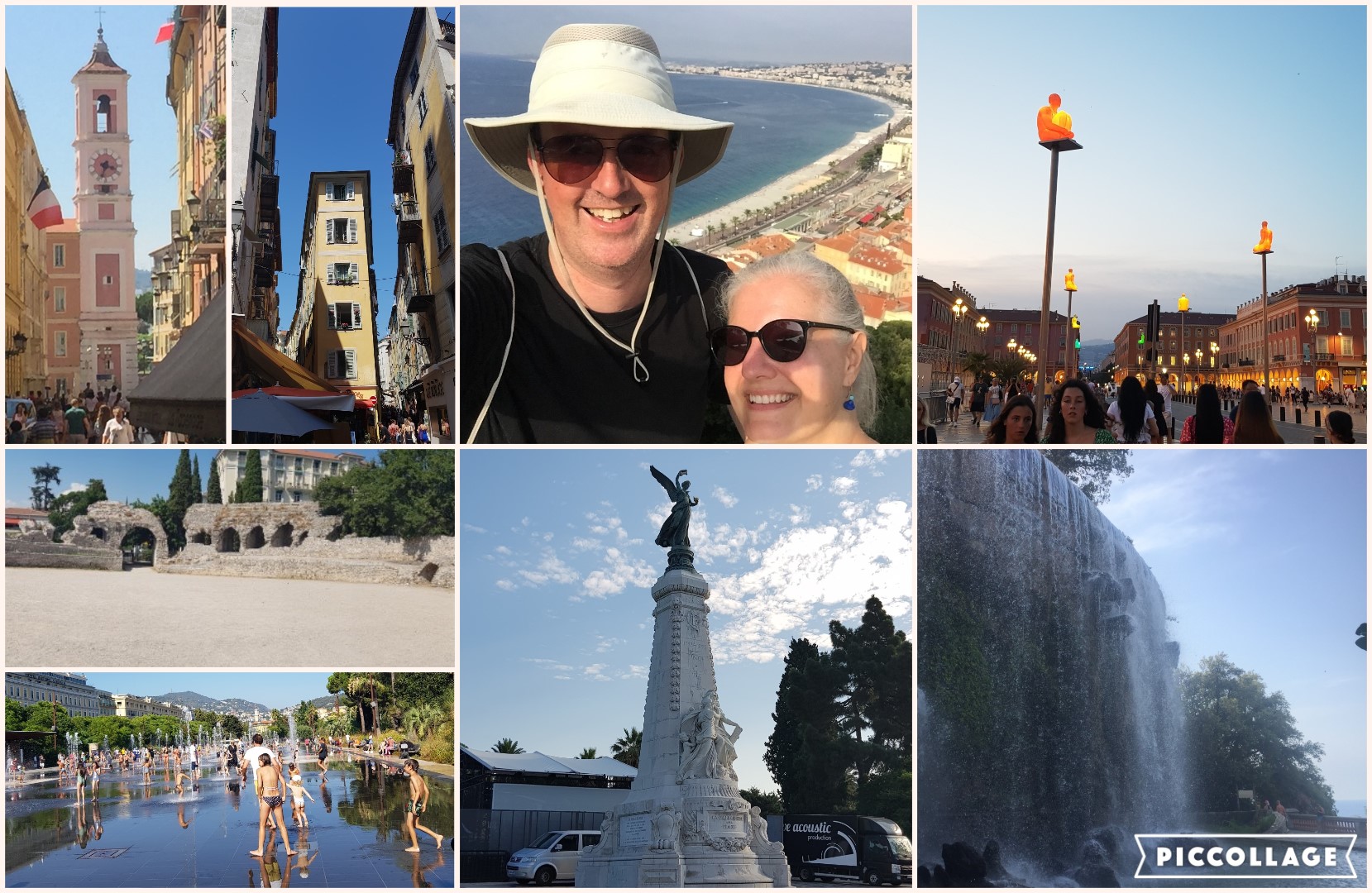 We spent a couple of days exploring. One day we went to The Matisse and Chagall Museums. The Chagall definitely left us wanting to learn more about his work. Another day we climbed to the top of Castle Hill overlooking the city where there archaeologists are in the process of learning more about the fort that was there.
We spent a couple of days exploring. One day we went to The Matisse and Chagall Museums. The Chagall definitely left us wanting to learn more about his work. Another day we climbed to the top of Castle Hill overlooking the city where there archaeologists are in the process of learning more about the fort that was there. The biggest chunk of our time in Paris was spent in the many incredible museums. The Louvre was of course incredible. We planned ahead enough to get 9:00 am tickets; we hightailed it to the Mona Lisa before the crowds became unmanageable. We spent time in the Islamic Art collection before finding our other must-see pieces — Liberty Leading the People, Winged Victory, and The Venus de Milo. Then we just wandered through the many galleries, getting distracted by whatever caught our eye, appreciating the many ways people experience the art, and being generally overwhelmed by the splendor of the building and its contents.
The biggest chunk of our time in Paris was spent in the many incredible museums. The Louvre was of course incredible. We planned ahead enough to get 9:00 am tickets; we hightailed it to the Mona Lisa before the crowds became unmanageable. We spent time in the Islamic Art collection before finding our other must-see pieces — Liberty Leading the People, Winged Victory, and The Venus de Milo. Then we just wandered through the many galleries, getting distracted by whatever caught our eye, appreciating the many ways people experience the art, and being generally overwhelmed by the splendor of the building and its contents.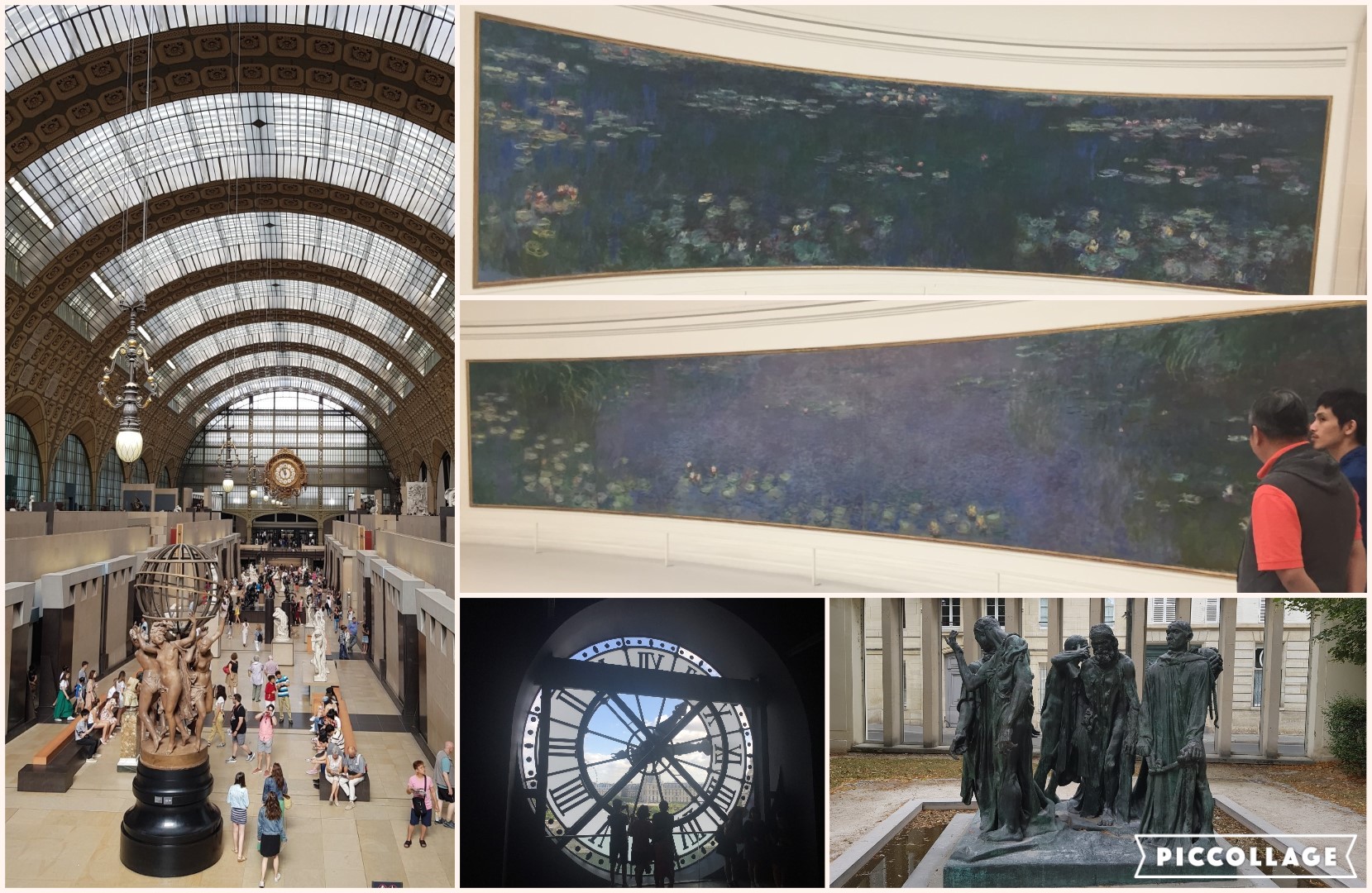 We also loved l’Orangerie with its stunning permanent installation of Monet’s Water Lilies, as well as the Orsay and its late 19th to early 20th century art, including of course the Impressionists. Rodin is one of our favorites, and of course Parisians love their own. Tom also took a spur-of-the-moment trip to a museum set up in Eugene Delacroix’s studio.
We also loved l’Orangerie with its stunning permanent installation of Monet’s Water Lilies, as well as the Orsay and its late 19th to early 20th century art, including of course the Impressionists. Rodin is one of our favorites, and of course Parisians love their own. Tom also took a spur-of-the-moment trip to a museum set up in Eugene Delacroix’s studio.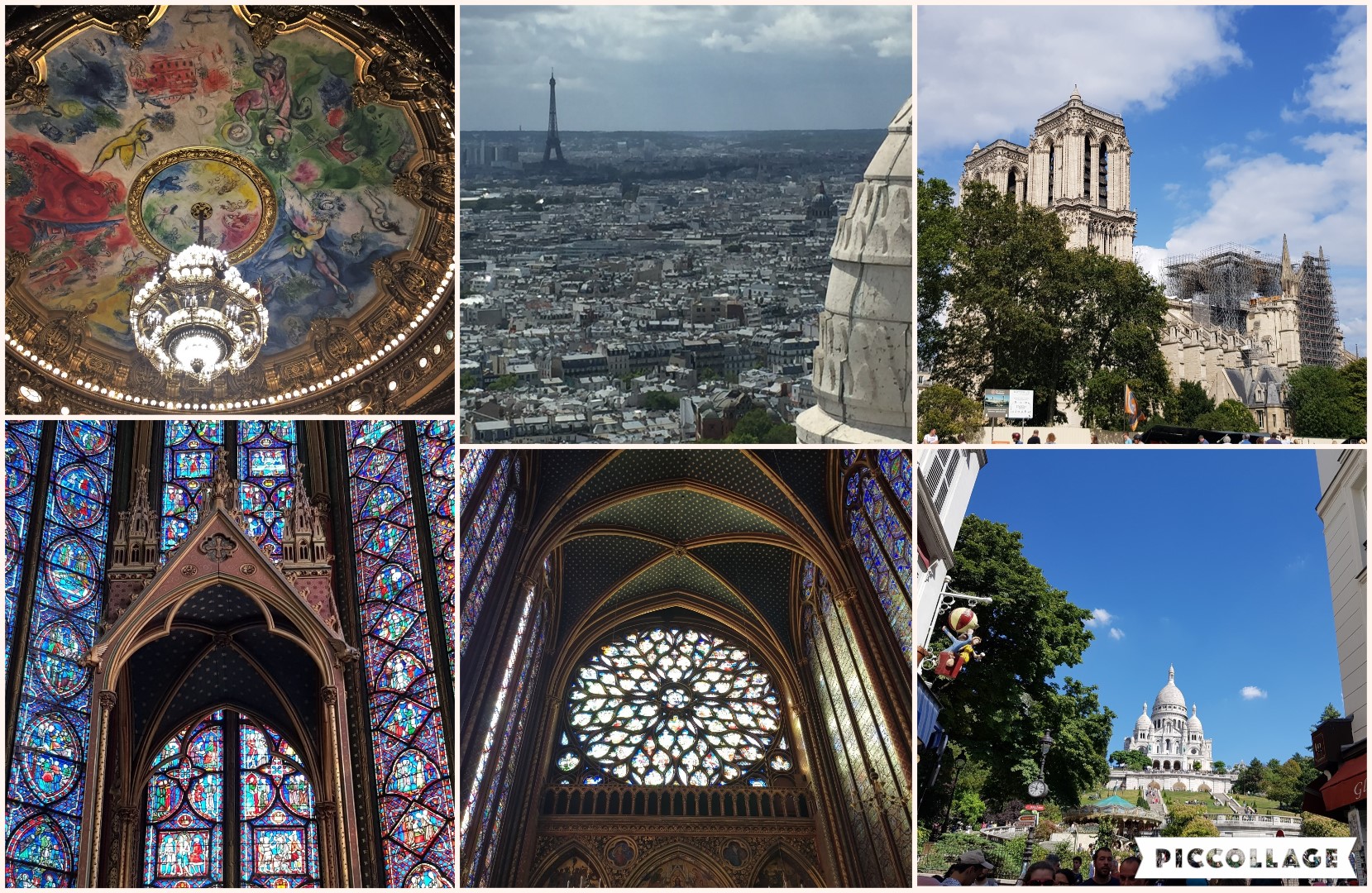 We also of course went to a few of the countless incredible cultural sites around Paris. Sainte Chapelle’s stained glass windows are incredible. We mourned the loss of post-fire Notre Dame. While Melissa took a shopping day, Tom saw the eerie Conciergerie where enemies of the revolution were condemned to the guillotine, and he also saw two Holocaust memorials — one specifically remembering the deportations from France and the Shoah Memorial. He also ducked into the Opera house to check out the Chagall ceiling we read about in Nice. Our favorite view of the city came from the top of Sacré-Cœur in Montmartre.
We also of course went to a few of the countless incredible cultural sites around Paris. Sainte Chapelle’s stained glass windows are incredible. We mourned the loss of post-fire Notre Dame. While Melissa took a shopping day, Tom saw the eerie Conciergerie where enemies of the revolution were condemned to the guillotine, and he also saw two Holocaust memorials — one specifically remembering the deportations from France and the Shoah Memorial. He also ducked into the Opera house to check out the Chagall ceiling we read about in Nice. Our favorite view of the city came from the top of Sacré-Cœur in Montmartre.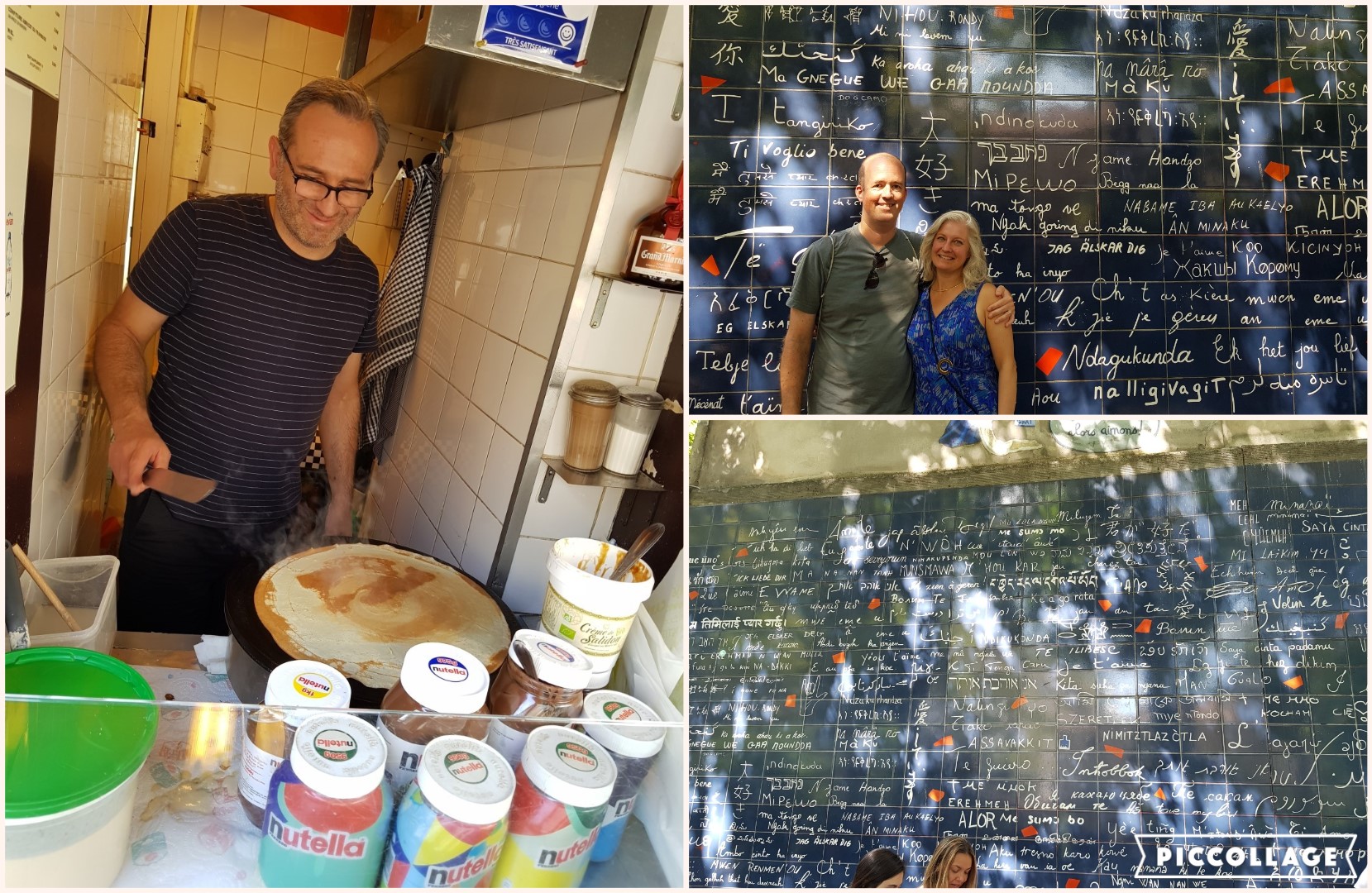 Speaking of Montmartre, we took an enjoyable food tour of the neighborhood with
Speaking of Montmartre, we took an enjoyable food tour of the neighborhood with 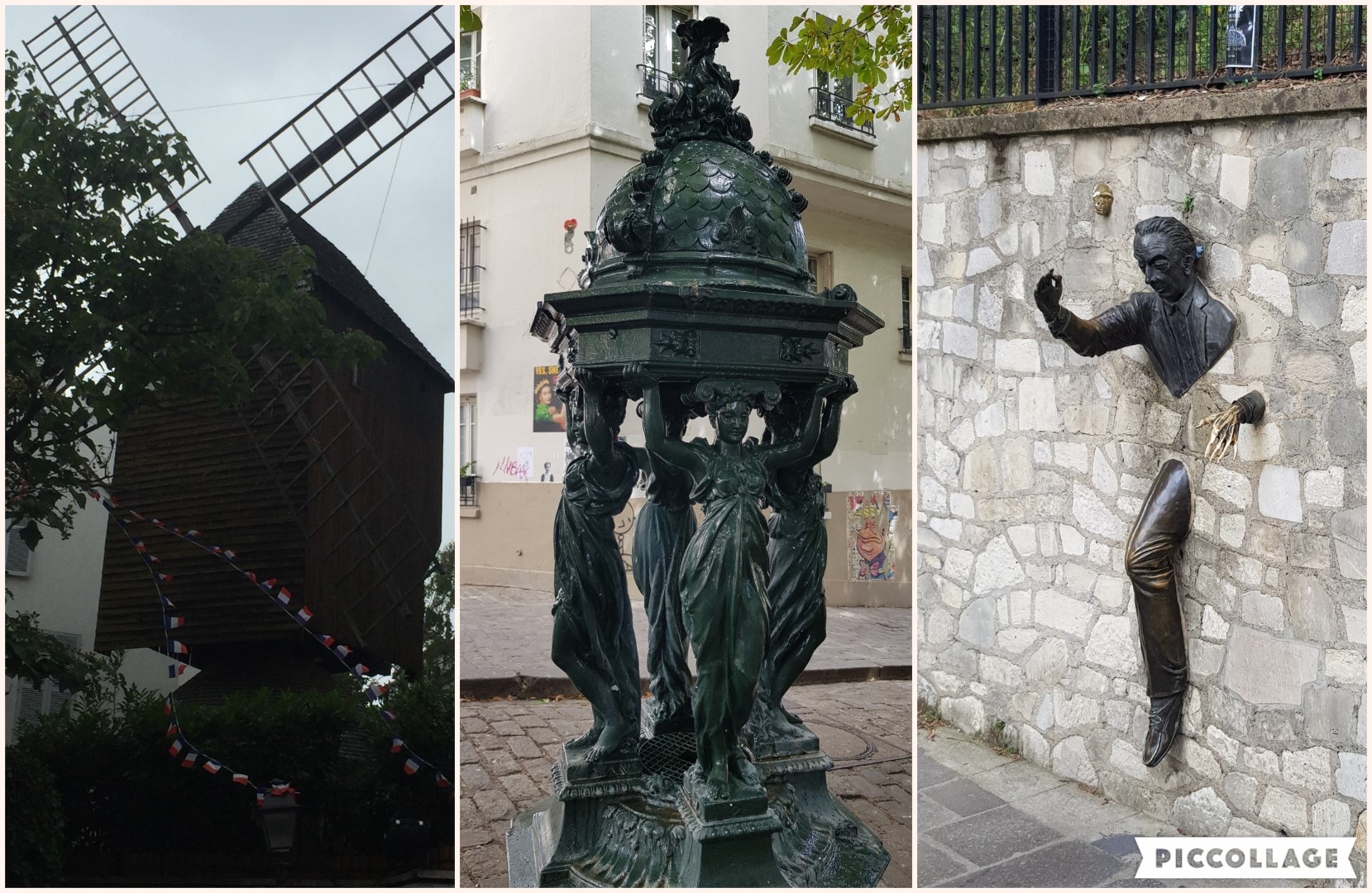 As we settled in to lunch, our guide happened to mention that they were piloting a wine tour the next day and wondered . . . “YES PLEASE!” we and the couple from Seattle answered before the end of the question. The next day we went on another walking tour of Montmartre, this time hearing about the history of wine in the neighborhood. There is still a small vineyard on the shady side of the hill producing a truly terrible wine. We drank wine and ate cheese at a variety of outlets. It was delicious, and all we had to do was answer some reflection questions about the tour itself and be interviewed for a marketing video.
As we settled in to lunch, our guide happened to mention that they were piloting a wine tour the next day and wondered . . . “YES PLEASE!” we and the couple from Seattle answered before the end of the question. The next day we went on another walking tour of Montmartre, this time hearing about the history of wine in the neighborhood. There is still a small vineyard on the shady side of the hill producing a truly terrible wine. We drank wine and ate cheese at a variety of outlets. It was delicious, and all we had to do was answer some reflection questions about the tour itself and be interviewed for a marketing video.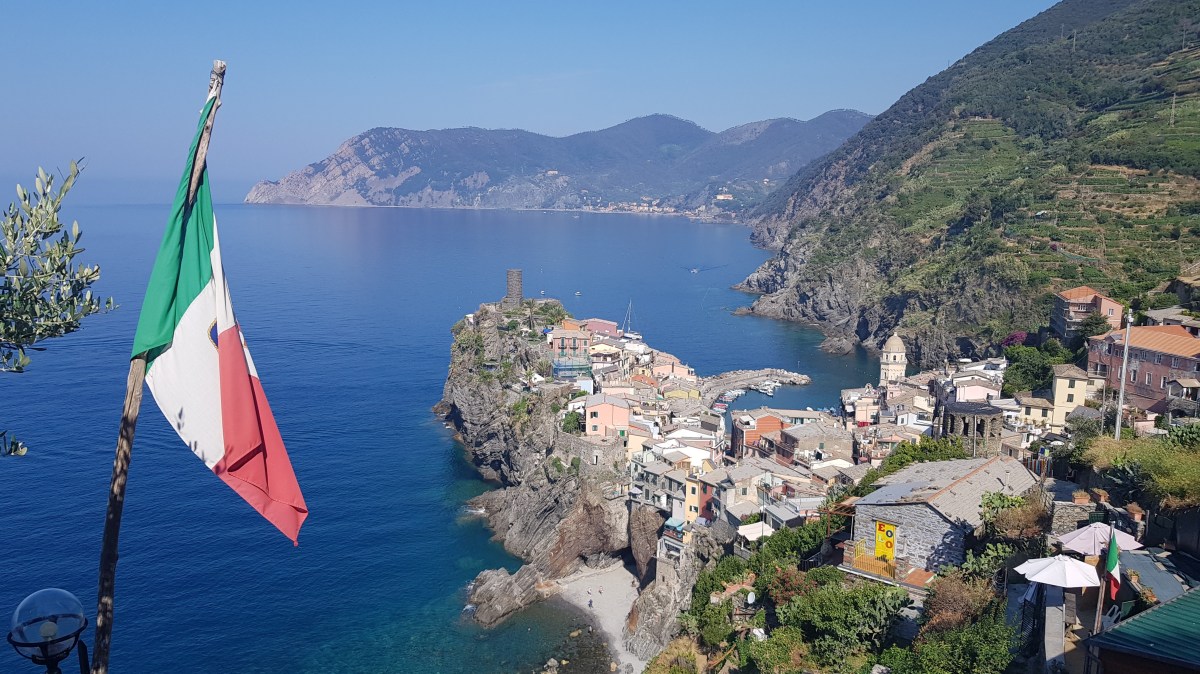
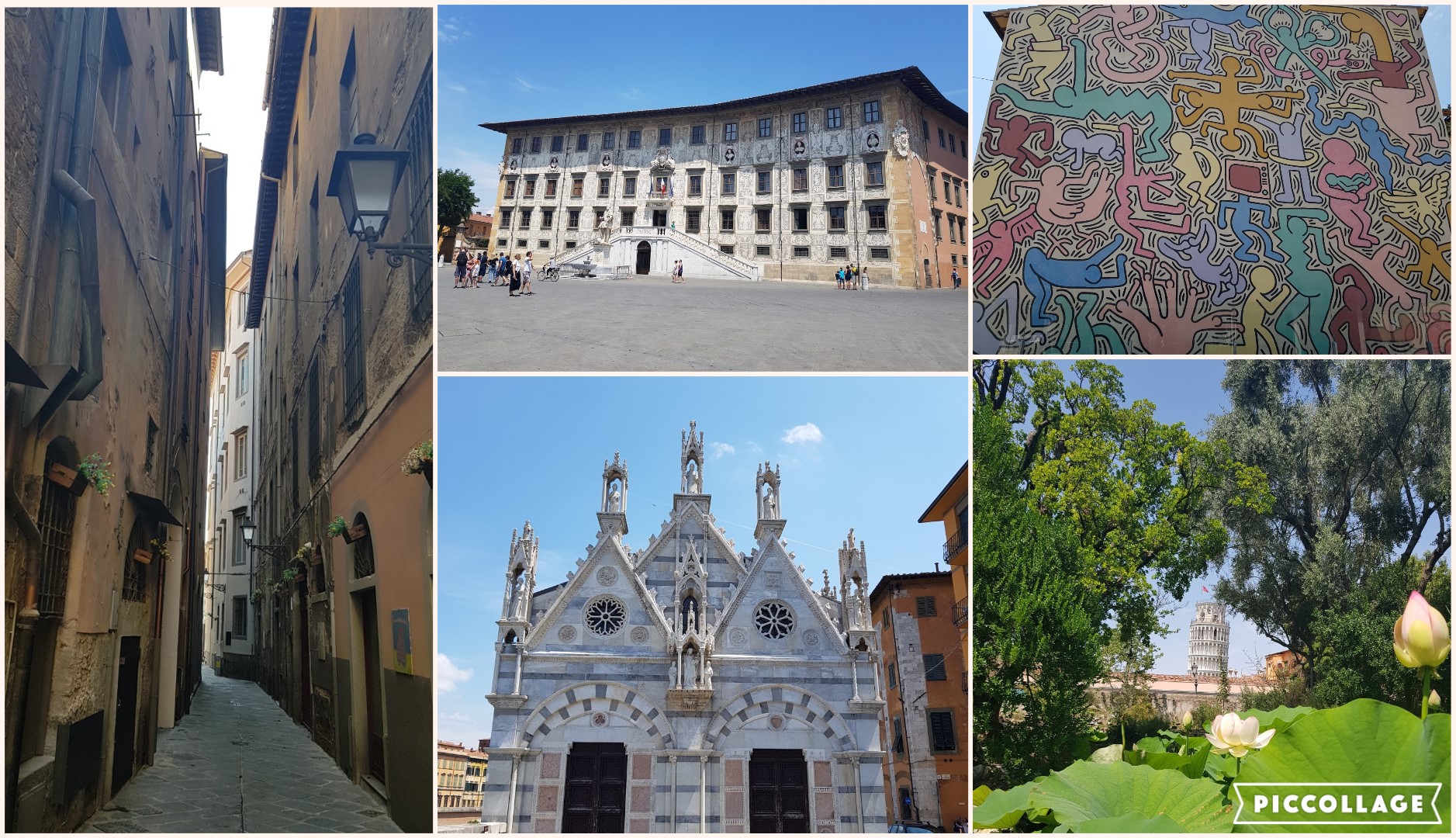



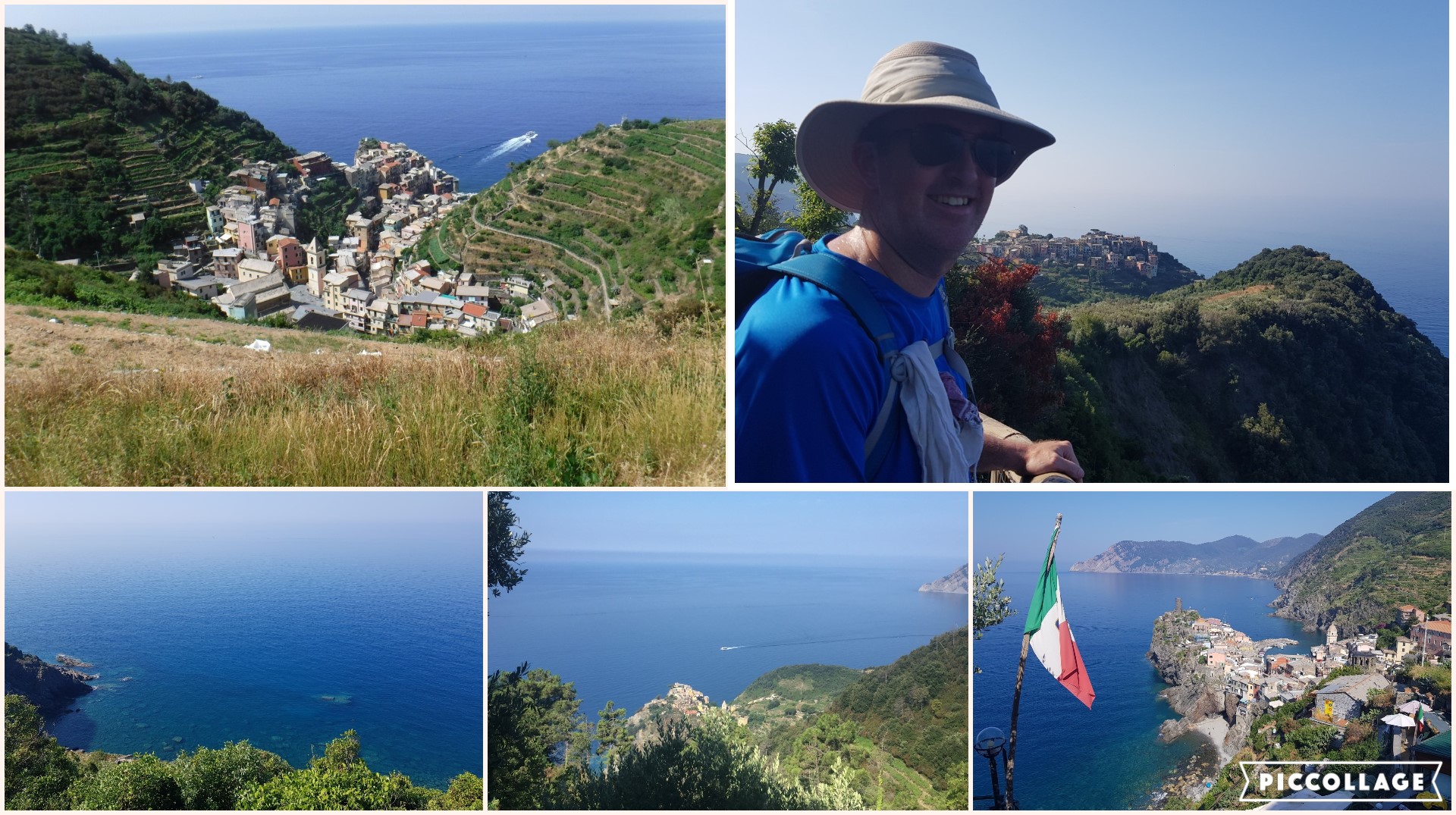
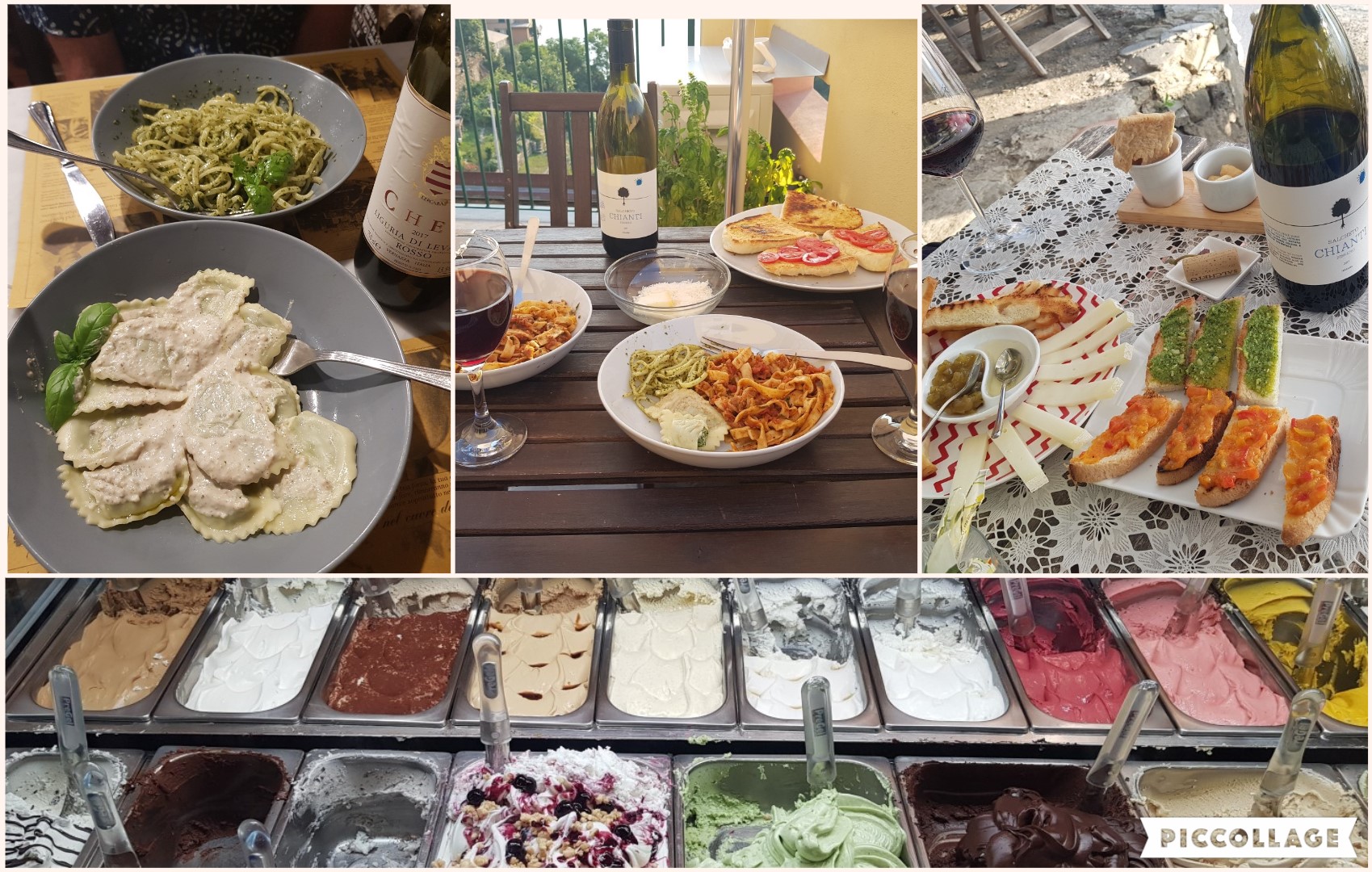


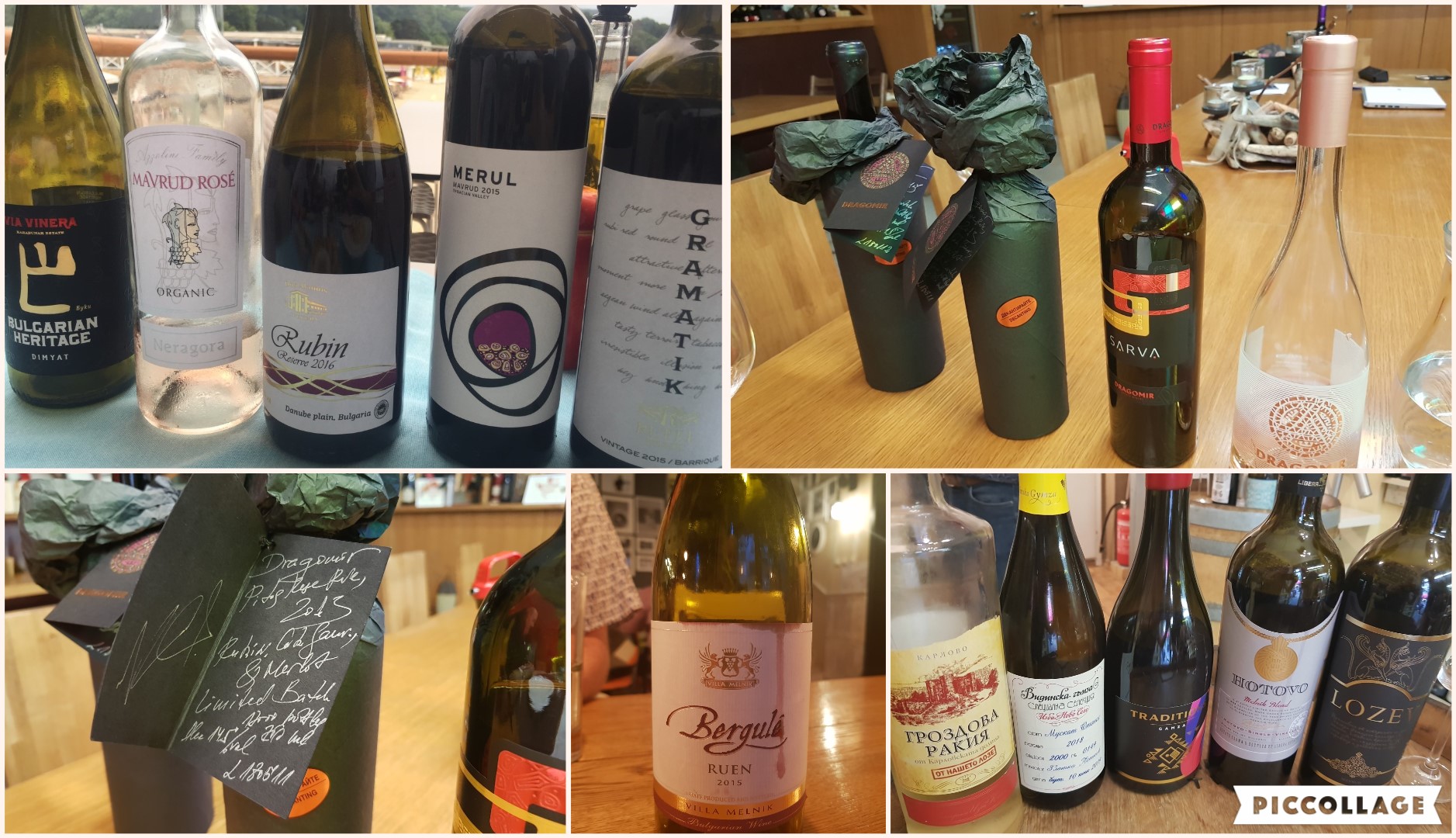

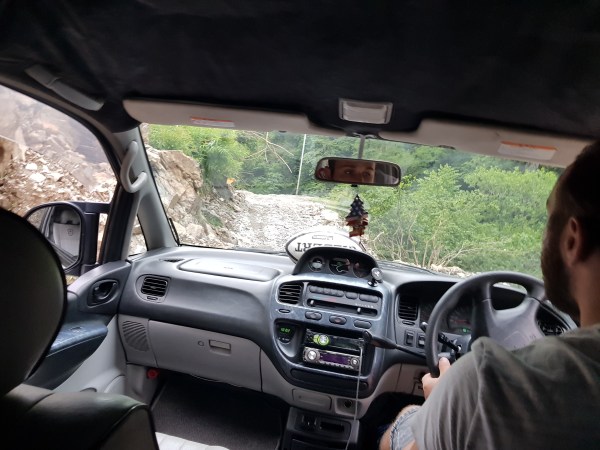 landsldes? “Alcohol” was the answer of one of our new friends), arriving in Shenako, a Tusheti village. On the way, our driver stopped to introduce us to our guide, which was the first we learned of having a guide at all, and explained that our luggage would be carried on horseback. Irakli was a giant with a sweet smile and warm handshake, but no English at all. With our lack of Georgian, communication was pretty limited for the next few days.
landsldes? “Alcohol” was the answer of one of our new friends), arriving in Shenako, a Tusheti village. On the way, our driver stopped to introduce us to our guide, which was the first we learned of having a guide at all, and explained that our luggage would be carried on horseback. Irakli was a giant with a sweet smile and warm handshake, but no English at all. With our lack of Georgian, communication was pretty limited for the next few days.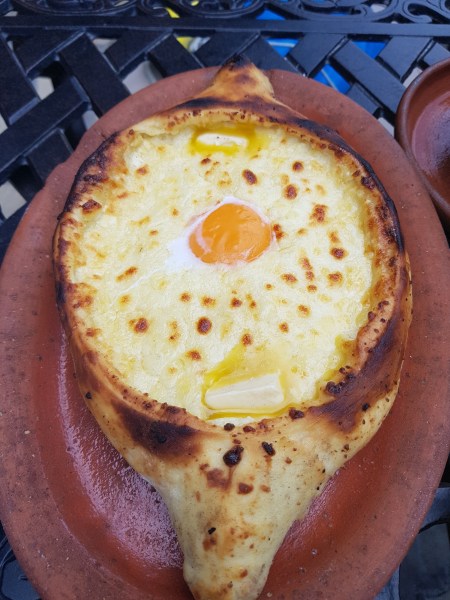 Khachapuri is a kind of stuffed cheese bread that varies from region to region, all of them delicious. Adjarian khachapuri is a boat-shaped yeasted bread filled with a cheese mixture, then topped with a soft egg yolk that is stirred into the cheese while eating (Melissa preferred hers eggless). Throughout Tusheti, Imeretian khachapuri looks kind of like a big round quesadilla stuffed with a mild sheep’s cheese and fried in lots of oil, and in Telavi it is similar to Imeretian khachapuri but is somehow less greasy and more cakey.
Khachapuri is a kind of stuffed cheese bread that varies from region to region, all of them delicious. Adjarian khachapuri is a boat-shaped yeasted bread filled with a cheese mixture, then topped with a soft egg yolk that is stirred into the cheese while eating (Melissa preferred hers eggless). Throughout Tusheti, Imeretian khachapuri looks kind of like a big round quesadilla stuffed with a mild sheep’s cheese and fried in lots of oil, and in Telavi it is similar to Imeretian khachapuri but is somehow less greasy and more cakey. Khinkali is a stuffed dumpling, mostly stuffed with meat (one fellow traveler described with ecstasy sucking the juices out of a mutton khinkali he had recently enjoyed) but we were able to find vegetarian versions almost everywhere we went. We have a theory, that one could write a pretty interesting book about flatbreads around the world, because flatbread seems to be found in every culture we have been exposed to. It is becoming increasingly clear that dumplings would make a pretty interesting book, too. Georgia’s version are large, plump, you eat them with your fingers, and they are delicious. As as added bonus, we were treated to a khinkali forming lesson in Shenako by our wonderful host Daro.
Khinkali is a stuffed dumpling, mostly stuffed with meat (one fellow traveler described with ecstasy sucking the juices out of a mutton khinkali he had recently enjoyed) but we were able to find vegetarian versions almost everywhere we went. We have a theory, that one could write a pretty interesting book about flatbreads around the world, because flatbread seems to be found in every culture we have been exposed to. It is becoming increasingly clear that dumplings would make a pretty interesting book, too. Georgia’s version are large, plump, you eat them with your fingers, and they are delicious. As as added bonus, we were treated to a khinkali forming lesson in Shenako by our wonderful host Daro.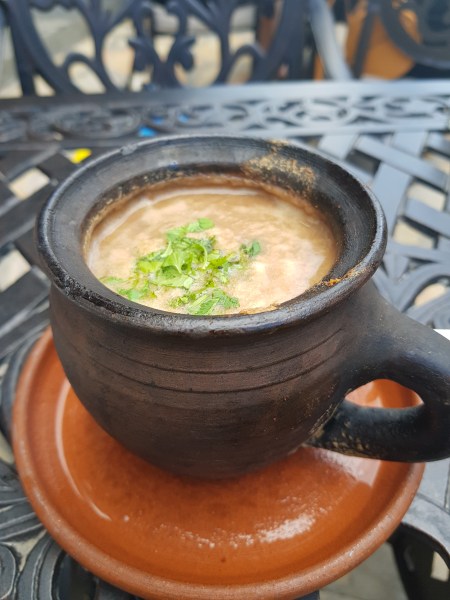 Lobio is a bean stew that can be cooked until nearly the consistency of refried beans, and is served with corn bread and pickled cucumbers, carrots, and herbs. Yum.
Lobio is a bean stew that can be cooked until nearly the consistency of refried beans, and is served with corn bread and pickled cucumbers, carrots, and herbs. Yum.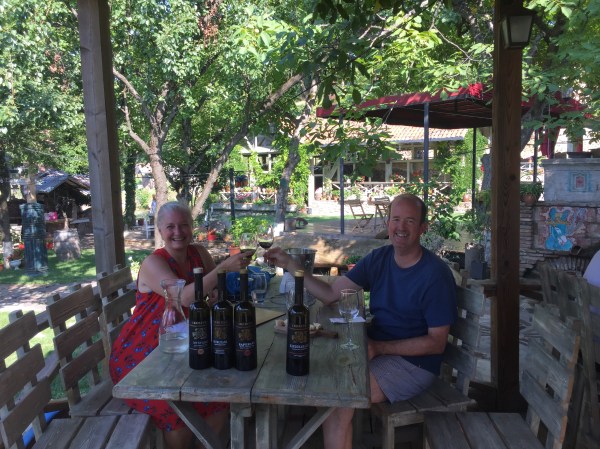 The wine is made differently here in qvevri which are large clay vessels lined with beeswax, generally underground with just the top of the vessel accessible. Our first tasting was a little alarming, when we didn’t particularly like any of the four wines we tried. We weren’t ready to give up, though, and visited a different place the next day where we enjoyed them all, and found one we really liked, called Mukuzani. It was a little telling when we learned that Mukuzani is made with the same grape, saperavi, as the more overwhelming wines, but aged for some time (different for each wine maker) in oak barrels, what they called the European method. Our favorite stop on our wine tour outside of Telavi was Shumi winery, partially because they make some very good wines, but it was also simply a beautiful and relaxing place to be. Georgia is famous for its amber wine (which we call orange wine in the US). Our favorite amber wine was made by our host at our guest house in Telavi. It was lovely.
The wine is made differently here in qvevri which are large clay vessels lined with beeswax, generally underground with just the top of the vessel accessible. Our first tasting was a little alarming, when we didn’t particularly like any of the four wines we tried. We weren’t ready to give up, though, and visited a different place the next day where we enjoyed them all, and found one we really liked, called Mukuzani. It was a little telling when we learned that Mukuzani is made with the same grape, saperavi, as the more overwhelming wines, but aged for some time (different for each wine maker) in oak barrels, what they called the European method. Our favorite stop on our wine tour outside of Telavi was Shumi winery, partially because they make some very good wines, but it was also simply a beautiful and relaxing place to be. Georgia is famous for its amber wine (which we call orange wine in the US). Our favorite amber wine was made by our host at our guest house in Telavi. It was lovely.
 and her desire to return. When Madlene and her family moved to Armenia and Melissa moved to Portland, they remained connected through Facebook, and Madlene’s photos of her beautiful city and stories of the 2018 Velvet Revolution fueled our desire to visit.
and her desire to return. When Madlene and her family moved to Armenia and Melissa moved to Portland, they remained connected through Facebook, and Madlene’s photos of her beautiful city and stories of the 2018 Velvet Revolution fueled our desire to visit.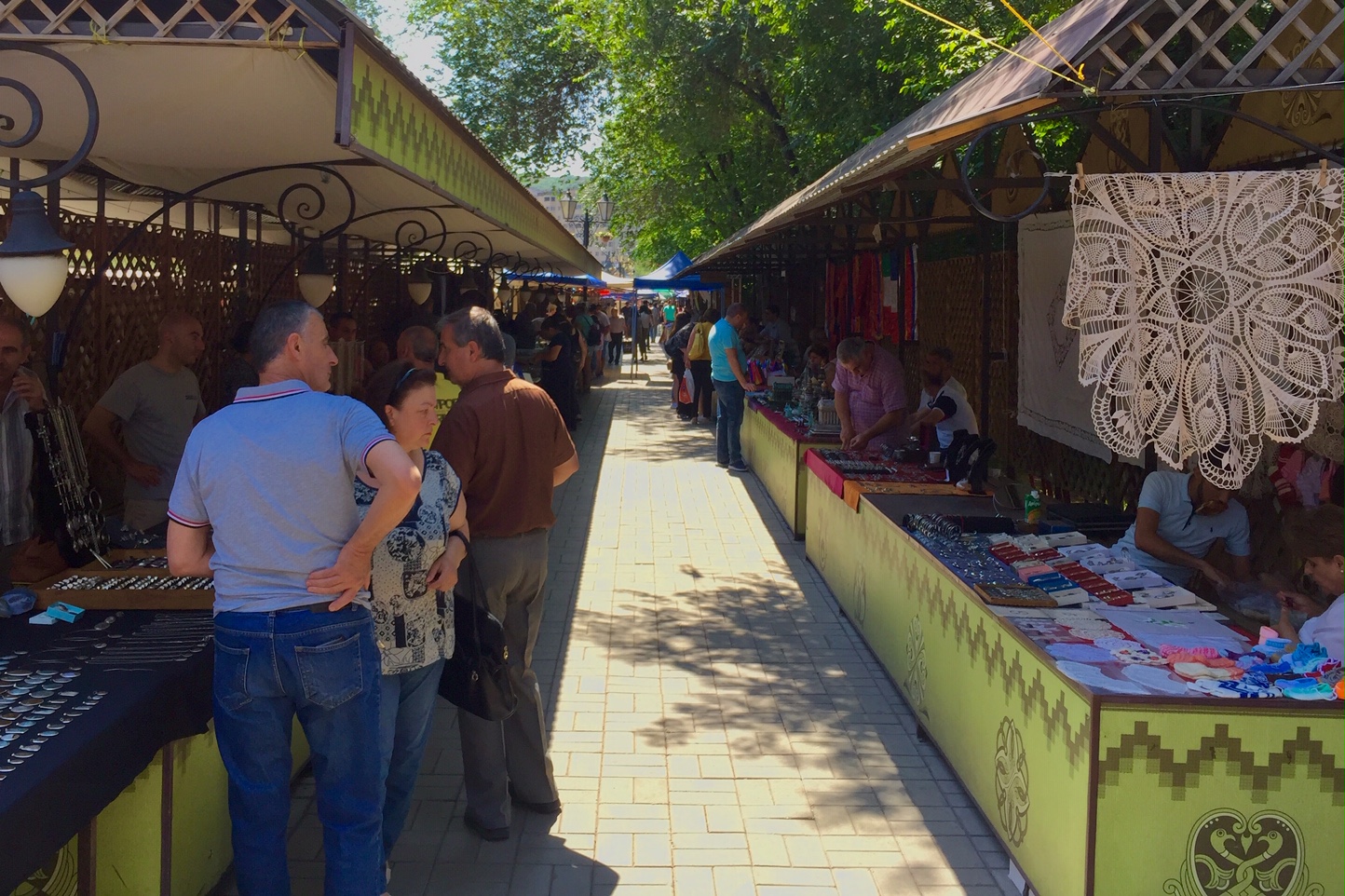 We made a few very good choices, mostly thanks to Madlene and her family. They spent a day showing off the city they love, including Vernissage, an amazing market of everything from traditional crafts to Soviet-era antiques to rugs from every region surrounding Armenia. They even took us on our first Metro ride to the train station to buy our tickets for our trip to Tbilisi a few days later. While there, Madlene showed us around an old Soviet train union building a friend of hers is rehabbing into co-working space, a cafe, and a general gathering place. The bulk of the day was spent at their summer home in Garni, a village just outside of Yerevan, that had belonged to the family of her husband, Arthur Ispiryan, for many generations.
We made a few very good choices, mostly thanks to Madlene and her family. They spent a day showing off the city they love, including Vernissage, an amazing market of everything from traditional crafts to Soviet-era antiques to rugs from every region surrounding Armenia. They even took us on our first Metro ride to the train station to buy our tickets for our trip to Tbilisi a few days later. While there, Madlene showed us around an old Soviet train union building a friend of hers is rehabbing into co-working space, a cafe, and a general gathering place. The bulk of the day was spent at their summer home in Garni, a village just outside of Yerevan, that had belonged to the family of her husband, Arthur Ispiryan, for many generations.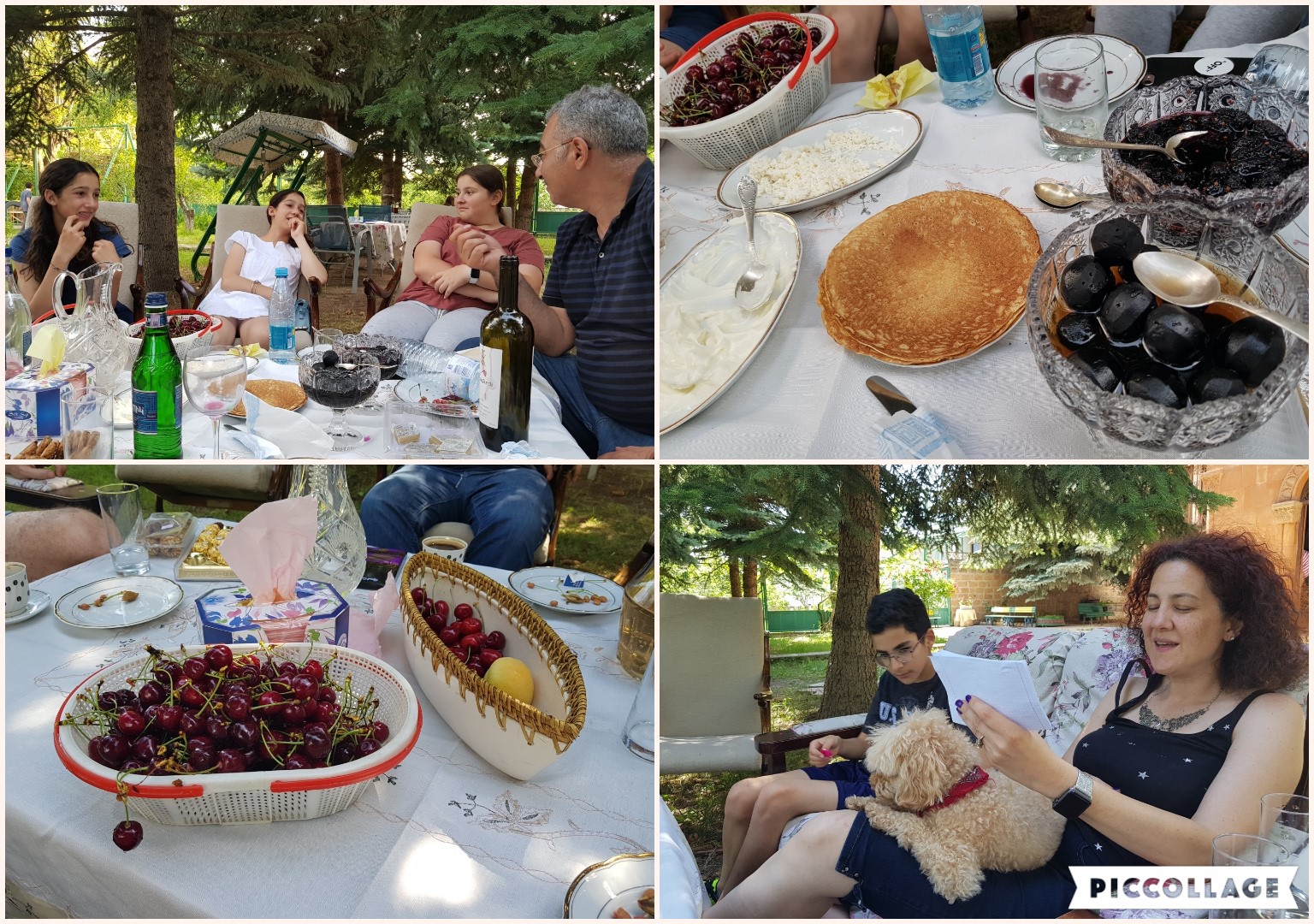 He and Madlene and Arthur’s mom are also incredible hosts. Two other families were visiting from LA, so they threw all of us a wonderful party at the summer house in Garni where Arthur’s mother lives full time during the summer. We ate apricots from nearby trees, three kinds of cherries from their trees and those next door, and drank rose juice that Arthur’s mom makes from the roses in the yard. After some time relaxing in the yard, we visited Geghard, a 4th century monastery carved from the cliffs. Being with Arthur meant an amazing treat – a quartet was there for another event, but wanted to sing for him in the cave room known for its amazing acoustics. It was impossible not to tear up while witnessing such beauty. After a return to the summer house for a fabulous dinner, we visited Garni, a 4000 year old Hellenistic temple. When Armenia became Christian in the 4th century, all of the old pagan temples were destroyed and churches were built in their place with the exception of this temple at Garni because the local princess asked to keep it as a summer residence. It was a powerful sight even visiting in the dark. The Armenians with us were all awe-struck and filled with pride for their heritage.
He and Madlene and Arthur’s mom are also incredible hosts. Two other families were visiting from LA, so they threw all of us a wonderful party at the summer house in Garni where Arthur’s mother lives full time during the summer. We ate apricots from nearby trees, three kinds of cherries from their trees and those next door, and drank rose juice that Arthur’s mom makes from the roses in the yard. After some time relaxing in the yard, we visited Geghard, a 4th century monastery carved from the cliffs. Being with Arthur meant an amazing treat – a quartet was there for another event, but wanted to sing for him in the cave room known for its amazing acoustics. It was impossible not to tear up while witnessing such beauty. After a return to the summer house for a fabulous dinner, we visited Garni, a 4000 year old Hellenistic temple. When Armenia became Christian in the 4th century, all of the old pagan temples were destroyed and churches were built in their place with the exception of this temple at Garni because the local princess asked to keep it as a summer residence. It was a powerful sight even visiting in the dark. The Armenians with us were all awe-struck and filled with pride for their heritage.
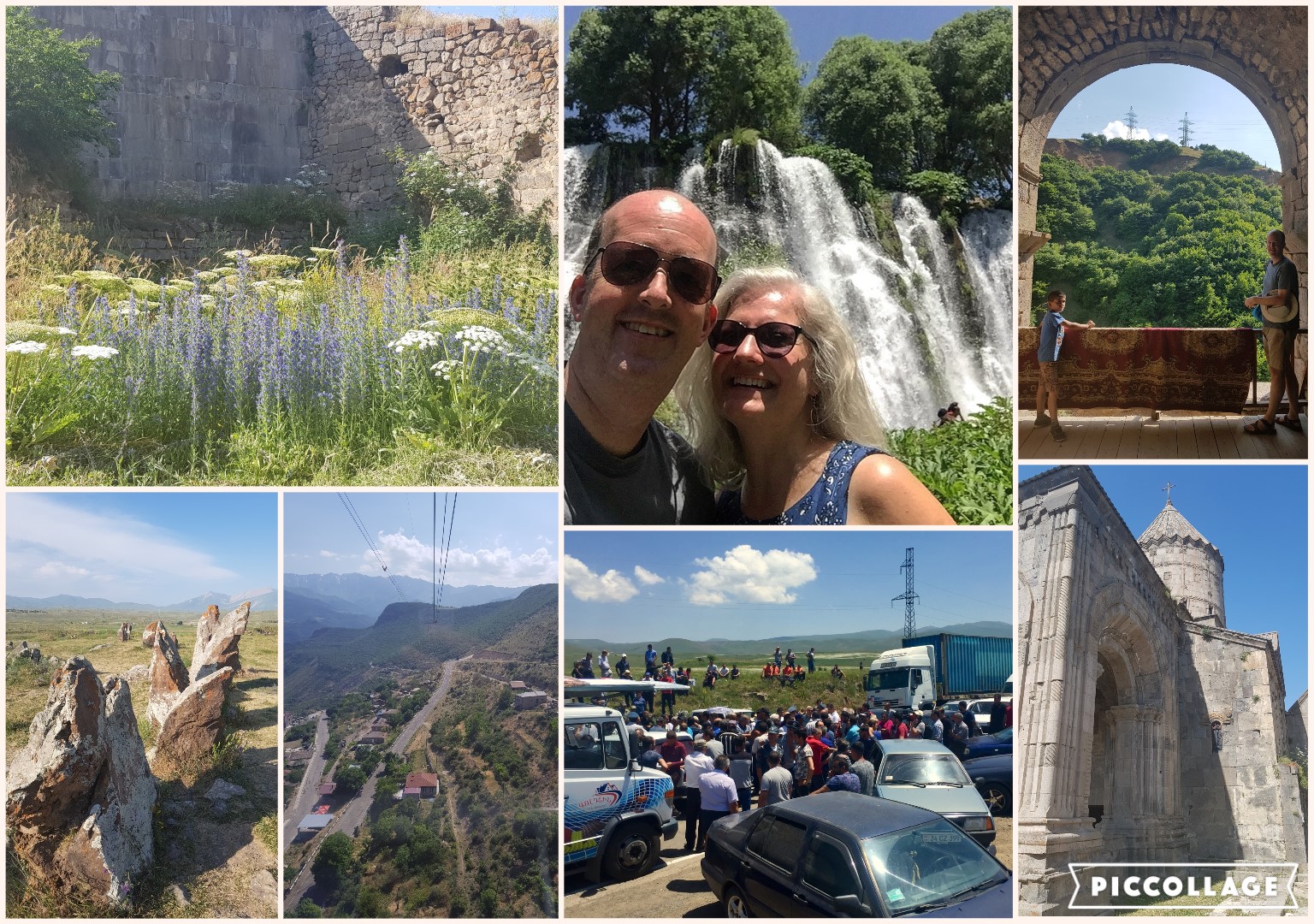 We were joined by more diaspora Armenians on our big tour day. The 14 hour tour included a lot of bus time interspersed with incredible sights. We saw the beautiful Shaki Waterfall, the 9th century Tatev Monastery with an even more ancient 5th century church on the grounds, the incredible views from the Wings of Tatev (the longest reversible cable car in the world), and Karahunj (Armenia’s 6,000 year old Stonehenge). We tasted wine in the region where folks recently discovered an ancient winery, also 6,00 years old. Throughout the day, we were treated to views of the beautiful scenery of Armenia – high desert, dense forest, towering mountains, and wildflowers everywhere. It was a long and delightful day.
We were joined by more diaspora Armenians on our big tour day. The 14 hour tour included a lot of bus time interspersed with incredible sights. We saw the beautiful Shaki Waterfall, the 9th century Tatev Monastery with an even more ancient 5th century church on the grounds, the incredible views from the Wings of Tatev (the longest reversible cable car in the world), and Karahunj (Armenia’s 6,000 year old Stonehenge). We tasted wine in the region where folks recently discovered an ancient winery, also 6,00 years old. Throughout the day, we were treated to views of the beautiful scenery of Armenia – high desert, dense forest, towering mountains, and wildflowers everywhere. It was a long and delightful day. On our last day, we visited Tsitsernakaberd, the Armenian Genocide Memorial Complex which was built in 1967 in response to Armenia’s agitation with their Soviet overlords. The memorial is truly moving, bringing many visitors to tears. In 1995, a museum was added which powerfully tells the story of Turkey’s incredibly brutal efforts to completely eliminate the Armenian people. Turkey seized the chaos of WWI to advance their plan, only stopped by the end of the war and Russian intervention. With a powerful need for protection in their vastly weakened state, they agreed to join the Soviet Union which dominated life there for the next 70 years.
On our last day, we visited Tsitsernakaberd, the Armenian Genocide Memorial Complex which was built in 1967 in response to Armenia’s agitation with their Soviet overlords. The memorial is truly moving, bringing many visitors to tears. In 1995, a museum was added which powerfully tells the story of Turkey’s incredibly brutal efforts to completely eliminate the Armenian people. Turkey seized the chaos of WWI to advance their plan, only stopped by the end of the war and Russian intervention. With a powerful need for protection in their vastly weakened state, they agreed to join the Soviet Union which dominated life there for the next 70 years.  Along the way, we had all kinds of good food, including traditional Armenian at Lavash and snacks at sidewalk cafes that line the streets and parks. We also celebrated Melissa’s mom’s birthday at India Mehak, our first Indian food in nearly a week! It is such a beautiful city, we mostly just enjoyed walking around gaping at the various styles of buildings, old Armenian, Soviet, and modern. Madlene confirmed what we had noticed about the streets of Yerevan, that they are really safe. Adolescent children, including her adorable sons David and Shahen, roam freely without a worry, and have done so since they were 9 years old.
Along the way, we had all kinds of good food, including traditional Armenian at Lavash and snacks at sidewalk cafes that line the streets and parks. We also celebrated Melissa’s mom’s birthday at India Mehak, our first Indian food in nearly a week! It is such a beautiful city, we mostly just enjoyed walking around gaping at the various styles of buildings, old Armenian, Soviet, and modern. Madlene confirmed what we had noticed about the streets of Yerevan, that they are really safe. Adolescent children, including her adorable sons David and Shahen, roam freely without a worry, and have done so since they were 9 years old.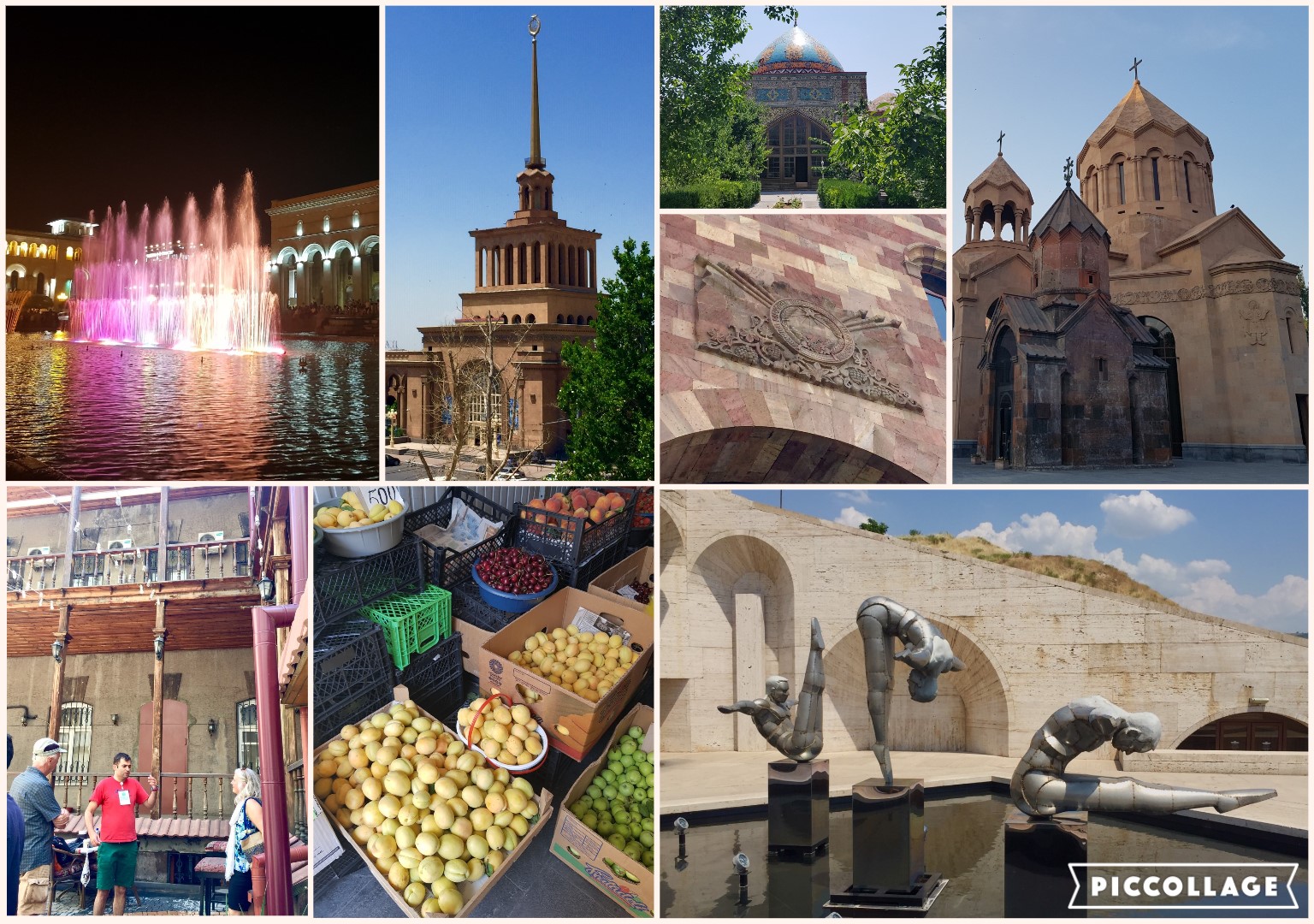 We left Armenia so aware of all the things we didn’t get to do, but so grateful for the things we did. This beautiful, charming, welcoming city is one we can easily imagine living in, and would certainly love to visit again.
We left Armenia so aware of all the things we didn’t get to do, but so grateful for the things we did. This beautiful, charming, welcoming city is one we can easily imagine living in, and would certainly love to visit again.
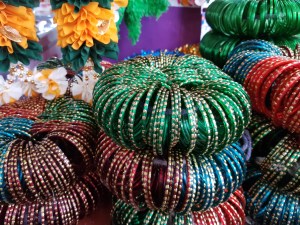 worldly cosmopolitan sensibilities. It is color, color, and more color from the flowering trees to the painted houses to the vivid sarees
worldly cosmopolitan sensibilities. It is color, color, and more color from the flowering trees to the painted houses to the vivid sarees  craftsmanship that produces anything from filigree jewelry to inlaid wooden tables to carved marble using the same techniques that have been used for countless generations. And the food! Oh, the wonderful food!
craftsmanship that produces anything from filigree jewelry to inlaid wooden tables to carved marble using the same techniques that have been used for countless generations. And the food! Oh, the wonderful food!
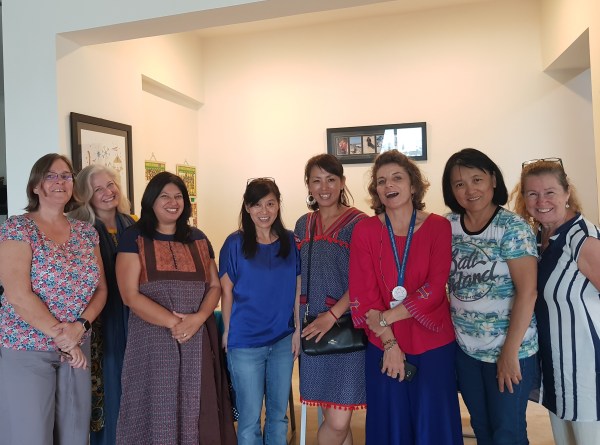 reasons. Some are here because work brought them or their partner here. Some are here because they fell in love with someone whose home is here. Some are here because their Indian heritage summoned them back. Some have always been here because Bangalore is home. I love hearing stories of lives so different from mine, and finding those common threads that connect us.
reasons. Some are here because work brought them or their partner here. Some are here because they fell in love with someone whose home is here. Some are here because their Indian heritage summoned them back. Some have always been here because Bangalore is home. I love hearing stories of lives so different from mine, and finding those common threads that connect us. Bangalore, and now beloved friends. Farrah introduced me to Shanti Bhavan and was my co-manager of the OWC North Region.
Bangalore, and now beloved friends. Farrah introduced me to Shanti Bhavan and was my co-manager of the OWC North Region.  Kaveri taught me more about culture and India than I ever imagined understanding. Together, they have given my time here joy and meaning, and it has been such an honor to get to know them while getting to know this big, crazy city.
Kaveri taught me more about culture and India than I ever imagined understanding. Together, they have given my time here joy and meaning, and it has been such an honor to get to know them while getting to know this big, crazy city.





 auto/rickshaw/tuk-tuk (names are interchangeable) with a driver who miraculously steers through crevices in traffic that feel smaller than the vehicle.
auto/rickshaw/tuk-tuk (names are interchangeable) with a driver who miraculously steers through crevices in traffic that feel smaller than the vehicle. thick branches and abundant shade
thick branches and abundant shade




 and some just tiny structures housing deities next to trees wrapped with ribbons.
and some just tiny structures housing deities next to trees wrapped with ribbons.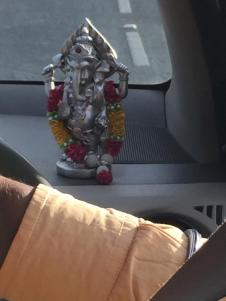 happy elephant-headed Ganesha; maybe a flying Hanuman, the monkey god, flying from the rearview mirror; maybe an ornate Lakshmi, the goddess of abundance, blessing the day’s work.
happy elephant-headed Ganesha; maybe a flying Hanuman, the monkey god, flying from the rearview mirror; maybe an ornate Lakshmi, the goddess of abundance, blessing the day’s work.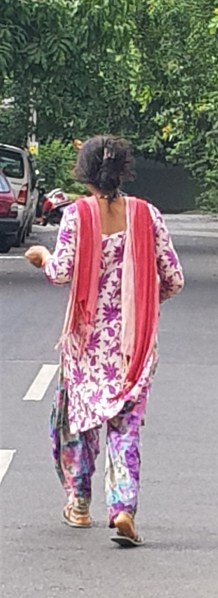 patterned kurta over chartreuse leggings in an opposing pattern with yet another color or pattern introduced in the dupatta, a scarf draped over the front of the body and trailing down the back; a red and gold saree draped beautifully around a woman while shopping or working; a wild rainbow of color whenever passing by a bus stop.
patterned kurta over chartreuse leggings in an opposing pattern with yet another color or pattern introduced in the dupatta, a scarf draped over the front of the body and trailing down the back; a red and gold saree draped beautifully around a woman while shopping or working; a wild rainbow of color whenever passing by a bus stop.









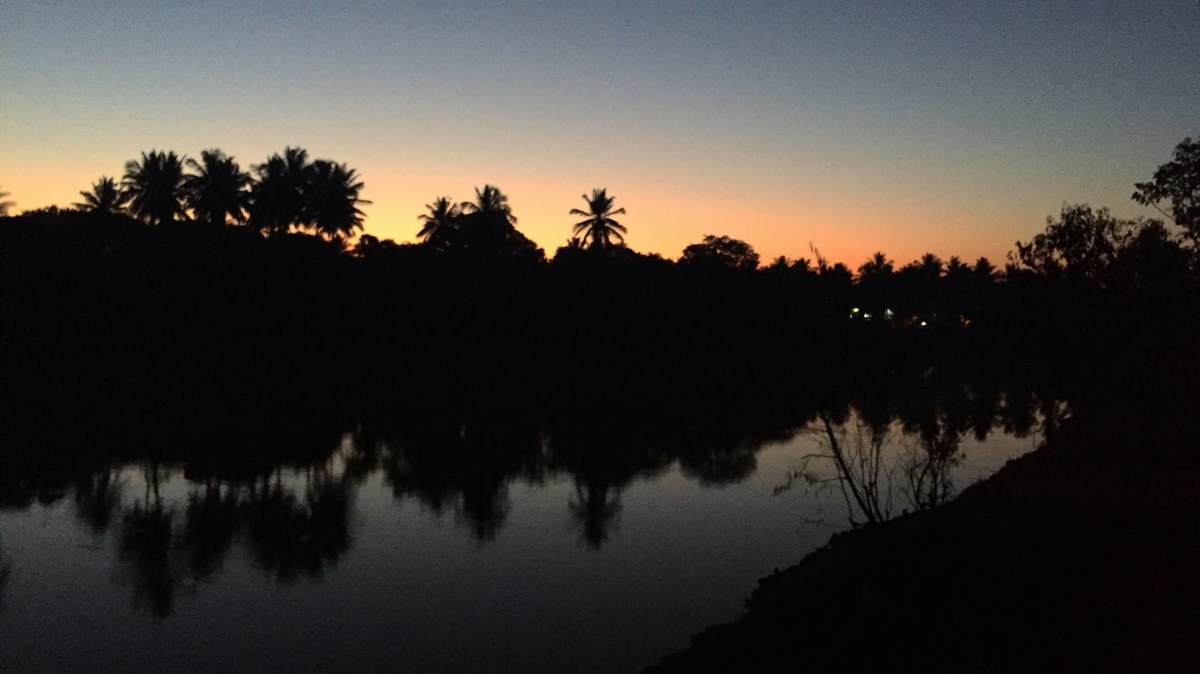
 Hinduism is a far more complex faith than I ever imagined, even taking into account that it is a religion involving thousands of gods. Doniger’s central thesis is that any explanation of Hinduism depends on whom you ask. There are a few central tenants, three primary gods, and common ancient texts, but she draws a picture in her readers’ minds of what she calls the “Zen Diagram,” a play on a venn diagram made up of countless circles, all interlocking with each other but with no central connecting piece on which all circles agree. When the monolithic Christianity, Islam, and Buddhism started to make inroads in what became India, the many branches of Hinduism came together into what the rest of the world now sees as a unified faith.
Hinduism is a far more complex faith than I ever imagined, even taking into account that it is a religion involving thousands of gods. Doniger’s central thesis is that any explanation of Hinduism depends on whom you ask. There are a few central tenants, three primary gods, and common ancient texts, but she draws a picture in her readers’ minds of what she calls the “Zen Diagram,” a play on a venn diagram made up of countless circles, all interlocking with each other but with no central connecting piece on which all circles agree. When the monolithic Christianity, Islam, and Buddhism started to make inroads in what became India, the many branches of Hinduism came together into what the rest of the world now sees as a unified faith. The largest group of people who have been “othered” for a long long time are the lower castes, the dalits, formerly known as “untouchables”. When one of those dalits, B.K. Ambedkar, wrote the constitution in the late 1940s with the caste system expressly written out of official Indian culture, there was hope that perhaps the divisions of the country based on the social standing of the family one was born into would no longer determine one’s future opportunities. Just as slavery and Jim Crow were outlawed a long time ago in the US but the racist social structure that persists keeps African Americans from realizing every opportunity, the caste system in India is still very much a reality, unofficial as it may be.
The largest group of people who have been “othered” for a long long time are the lower castes, the dalits, formerly known as “untouchables”. When one of those dalits, B.K. Ambedkar, wrote the constitution in the late 1940s with the caste system expressly written out of official Indian culture, there was hope that perhaps the divisions of the country based on the social standing of the family one was born into would no longer determine one’s future opportunities. Just as slavery and Jim Crow were outlawed a long time ago in the US but the racist social structure that persists keeps African Americans from realizing every opportunity, the caste system in India is still very much a reality, unofficial as it may be. This is where I have to admit that I am biased. Melissa and I (mostly Melissa) have had the opportunity to meet and get to know Shilpa. She is a wonderful, gracious young woman who knows how lucky she is to have the opportunities she has and is dead set on making sure she spreads those opportunities to as many people as she can. When she spoke to a group of our very privileged kids at CIS, she enthralled them. The thing that my students told me most grabbed them comes back to Shilpa’s honesty; she truly answered their questions rather than repeating canned answers. We had the honor of going to the Shanti Bhavan graduation for one of our last weekends in Bangalore. Shilpa was a gracious host and tireless organizer. We are excited for her as she heads to Hofstra University on Long Island, New York to start her PhD program.
This is where I have to admit that I am biased. Melissa and I (mostly Melissa) have had the opportunity to meet and get to know Shilpa. She is a wonderful, gracious young woman who knows how lucky she is to have the opportunities she has and is dead set on making sure she spreads those opportunities to as many people as she can. When she spoke to a group of our very privileged kids at CIS, she enthralled them. The thing that my students told me most grabbed them comes back to Shilpa’s honesty; she truly answered their questions rather than repeating canned answers. We had the honor of going to the Shanti Bhavan graduation for one of our last weekends in Bangalore. Shilpa was a gracious host and tireless organizer. We are excited for her as she heads to Hofstra University on Long Island, New York to start her PhD program. A year ago I wrote about what I had learned in
A year ago I wrote about what I had learned in  Raghunathan frames the question around game theory of economics, particularly the Prisoner’s Dilemma. Two suspects in a crime have the opportunity to lighten their sentence. If both suspects betray each other, they will receive two year sentences each. If I betray my partner, but my partner remains silent, I will be set free while my partner will receive a three year sentence. If both of us remain silent, we both serve one year sentences. Simple behavioral economics points to the easy answer: By remaining silent, the total number of years served in prison is either two (split between us) or three (served by only one). The worst case is both betraying each other for a grand total of four years split between us. So both should know to remain silent, right? But what if my partner doesn’t know to be silent? Then I’m screwed. Raghunathan posits that the “I’m screwed” part is primary in his fellow Indians’ decision making. Corruption makes life more difficult for all of us, but if others are doing it and I’m not, then their lives are easier and, say it with me, “I’m screwed.” If we trusted each other to do the right thing, then we could all be better off, but the right thing seems to happen so rarely that I’m going to do what’s right for me and my family right now. The negative long term consequences aren’t for me to worry about right now if ever, so I’m not going to worry about them.
Raghunathan frames the question around game theory of economics, particularly the Prisoner’s Dilemma. Two suspects in a crime have the opportunity to lighten their sentence. If both suspects betray each other, they will receive two year sentences each. If I betray my partner, but my partner remains silent, I will be set free while my partner will receive a three year sentence. If both of us remain silent, we both serve one year sentences. Simple behavioral economics points to the easy answer: By remaining silent, the total number of years served in prison is either two (split between us) or three (served by only one). The worst case is both betraying each other for a grand total of four years split between us. So both should know to remain silent, right? But what if my partner doesn’t know to be silent? Then I’m screwed. Raghunathan posits that the “I’m screwed” part is primary in his fellow Indians’ decision making. Corruption makes life more difficult for all of us, but if others are doing it and I’m not, then their lives are easier and, say it with me, “I’m screwed.” If we trusted each other to do the right thing, then we could all be better off, but the right thing seems to happen so rarely that I’m going to do what’s right for me and my family right now. The negative long term consequences aren’t for me to worry about right now if ever, so I’m not going to worry about them. I expected Raghunathan in Games Indians Play to at least bring the self destructive behaviors he describes back to the Raj, the period of time that Britain ruled India, because it is an easy connection to make. He doesn’t do that, though, for good and bad. It is a convenient excuse which sometimes feels like a cop out, but he also fails to look for any of the underlying causes of the acceptance of these behaviors. Tharoor, in the engaging, brilliantly written and researched book Inglorious Empire takes a different tack. He looks in detail at what the Raj did to this country while challenging Indians to see history as a way to identify the cycles at work in Indian society that need to be broken in order to go forward and not use past crimes of the Raj as an excuse. Tharoor lays a foundation for figuring out how to make India a global superpower again, but it involves coming to grips with the fact that many of the social structures that Indians hold dear are holding India back and were designed by the British to do just that.
I expected Raghunathan in Games Indians Play to at least bring the self destructive behaviors he describes back to the Raj, the period of time that Britain ruled India, because it is an easy connection to make. He doesn’t do that, though, for good and bad. It is a convenient excuse which sometimes feels like a cop out, but he also fails to look for any of the underlying causes of the acceptance of these behaviors. Tharoor, in the engaging, brilliantly written and researched book Inglorious Empire takes a different tack. He looks in detail at what the Raj did to this country while challenging Indians to see history as a way to identify the cycles at work in Indian society that need to be broken in order to go forward and not use past crimes of the Raj as an excuse. Tharoor lays a foundation for figuring out how to make India a global superpower again, but it involves coming to grips with the fact that many of the social structures that Indians hold dear are holding India back and were designed by the British to do just that. Speaking of heartbreaking and corruption seemingly designed to keep the masses down, Behind the Beautiful Forevers. Boo describes life in Annawadi, a slum near the Mumbai airport. This is a story of people simply trying to survive. They occasionally make decisions that feed the stereotypes that allow the haters to point to them and “other” them, but they are really simply trying to survive. She follows a few families over the course of a few years, painting a picture of their tiny victories that are completely swamped by their crushing everyday lives. Every hope they have that something might change is quickly extinguished by the ubiquitous corrupt self interest, from the neighbor just trying to keep her family afloat to the city planners that allow the slum to happen in the first place.
Speaking of heartbreaking and corruption seemingly designed to keep the masses down, Behind the Beautiful Forevers. Boo describes life in Annawadi, a slum near the Mumbai airport. This is a story of people simply trying to survive. They occasionally make decisions that feed the stereotypes that allow the haters to point to them and “other” them, but they are really simply trying to survive. She follows a few families over the course of a few years, painting a picture of their tiny victories that are completely swamped by their crushing everyday lives. Every hope they have that something might change is quickly extinguished by the ubiquitous corrupt self interest, from the neighbor just trying to keep her family afloat to the city planners that allow the slum to happen in the first place. I figured I had to read at least one piece of fiction, and this was on my Kindle. How’s that for a high bar? This was an OK book. The patriarch was able to make his way up in the Indian Civil Service, a system the British put in place to curry favor with some Indians who were then treated with privilege not afforded others. Along the way he bought in to that privilege and thought pretty highly of himself. There are a few characters to cheer for — the cook, his son, the niece — whose lives are hard.
I figured I had to read at least one piece of fiction, and this was on my Kindle. How’s that for a high bar? This was an OK book. The patriarch was able to make his way up in the Indian Civil Service, a system the British put in place to curry favor with some Indians who were then treated with privilege not afforded others. Along the way he bought in to that privilege and thought pretty highly of himself. There are a few characters to cheer for — the cook, his son, the niece — whose lives are hard. I mentioned above that soon after arriving in India, the Supreme Court overturned Section 377, the British colonial law that banned acting on one’s homosexuality. One of the first conversations I had with who became one of my most dear and trusted colleagues pointed to the silence in which the law and cultural norms around homosexuality forced our gay students to live. The confluence of these events made it a subject I was interested in but had a hard time finding the right avenue for learning. About the time a grotesque act of homophobia at school inspired a profound symposium around working to embrace all people, Dube released An Indefinite Sentence, his memoir of growing up gay in India then working in the United States, India, and several global institutions as an advocate for gay rights, for sex worker rights, and to help stem the AIDS crisis.
I mentioned above that soon after arriving in India, the Supreme Court overturned Section 377, the British colonial law that banned acting on one’s homosexuality. One of the first conversations I had with who became one of my most dear and trusted colleagues pointed to the silence in which the law and cultural norms around homosexuality forced our gay students to live. The confluence of these events made it a subject I was interested in but had a hard time finding the right avenue for learning. About the time a grotesque act of homophobia at school inspired a profound symposium around working to embrace all people, Dube released An Indefinite Sentence, his memoir of growing up gay in India then working in the United States, India, and several global institutions as an advocate for gay rights, for sex worker rights, and to help stem the AIDS crisis.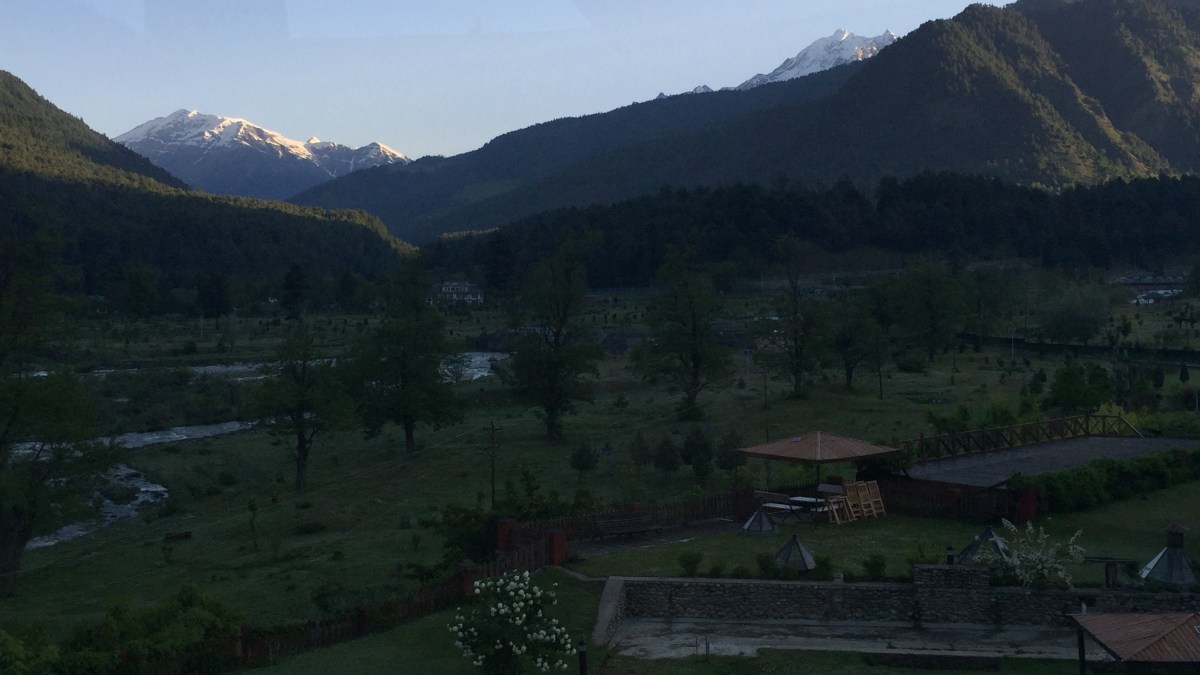
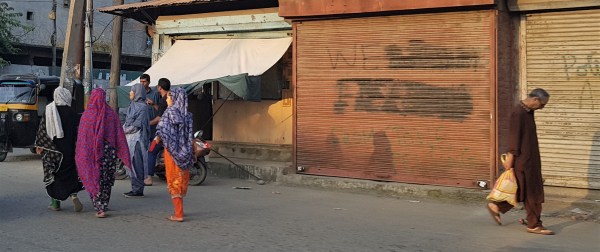 so different from what he had seen last year on his
so different from what he had seen last year on his 
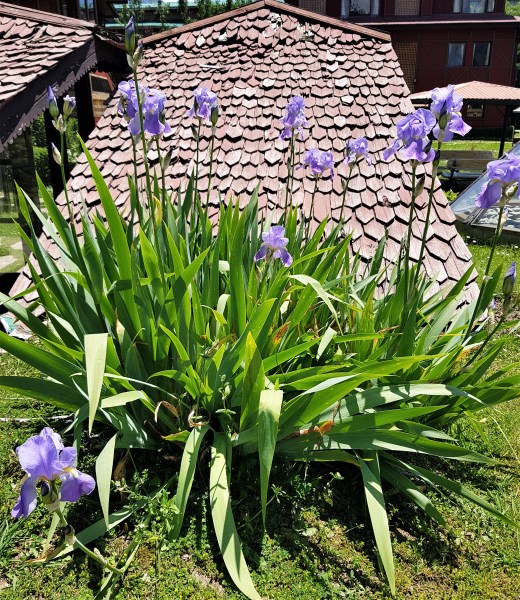 We arrived at midday at the Pahalgam Hotel, started by Ramneek’s great-grandfather on the banks of the Jhehlum River Tributary. With Ramneek’s nephew involved in the business, they are now into the fifth generation with this lovely hotel, and it is clearly treasured by everyone, family and staff alike. Our room had a separate bedroom, two bathrooms, and glorious views from every window. We were in heaven.
We arrived at midday at the Pahalgam Hotel, started by Ramneek’s great-grandfather on the banks of the Jhehlum River Tributary. With Ramneek’s nephew involved in the business, they are now into the fifth generation with this lovely hotel, and it is clearly treasured by everyone, family and staff alike. Our room had a separate bedroom, two bathrooms, and glorious views from every window. We were in heaven.
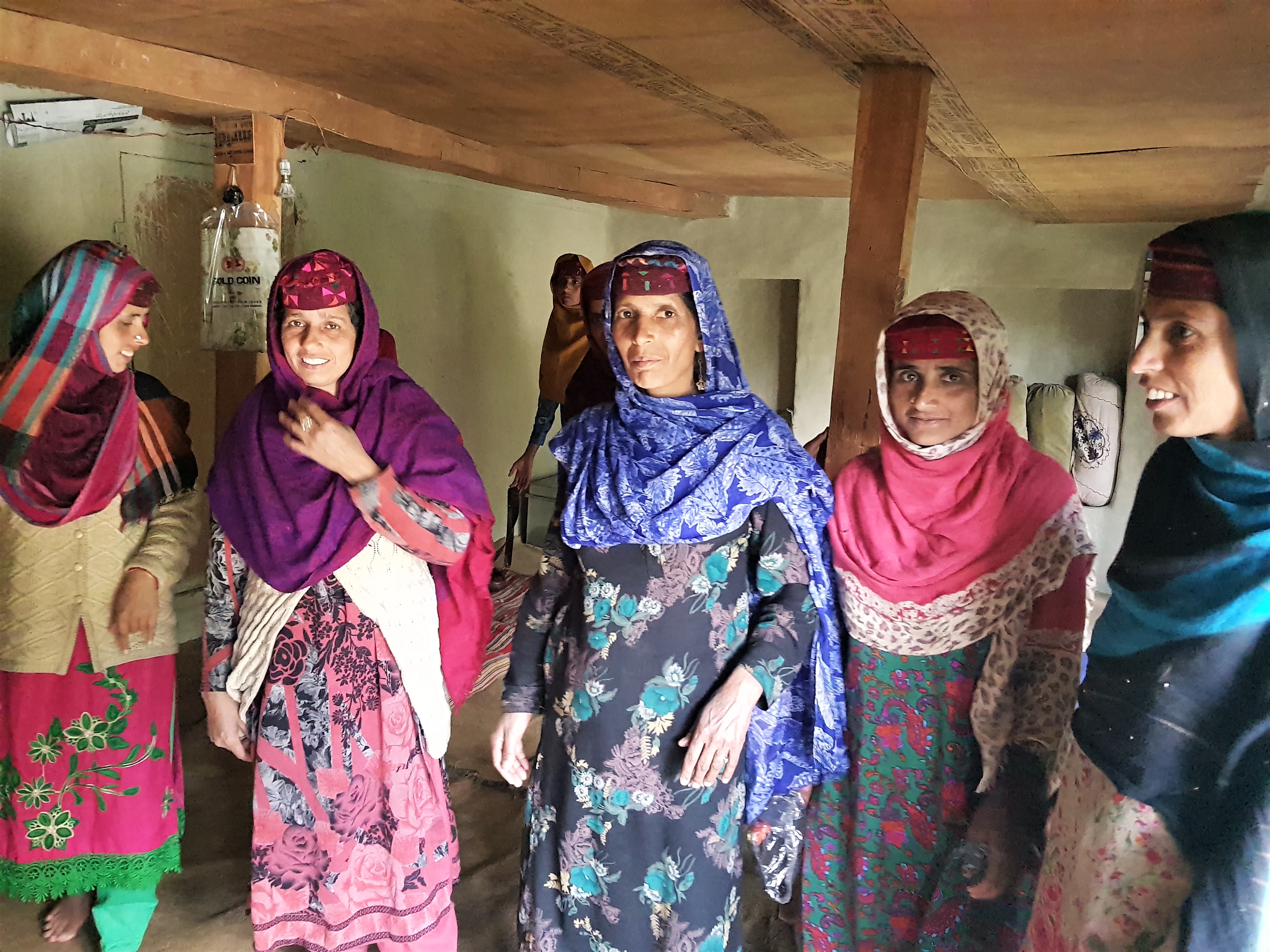

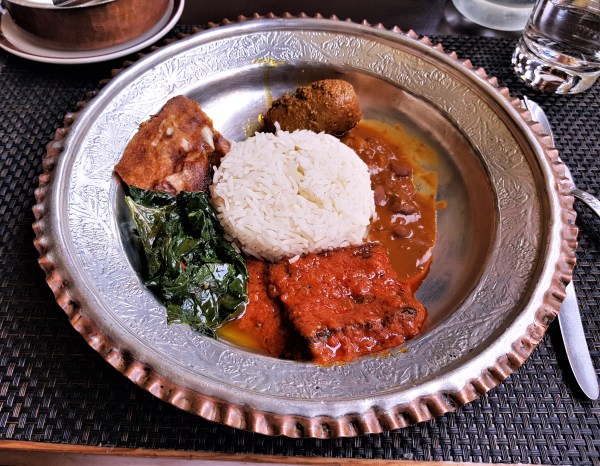 Given our general sleepiness, we had an early dinner, once again absolutely delicious. We were quite taken with the kalari cheese, a local delicacy that looks like a flat disc, tastes a bit like a combination mozzarella and halloumi and is served fried until crisp. Similarly, we found that the Kashmiri paneer is also more mozzarella-like with a sort of chewiness that we had never before had in paneer. Yum. That night we slept in the total darkness and perfect silence never experienced in Bangalore. We woke early with the birds, which is a very pleasant way to rise. Tea was served to us in our room and we enjoyed some time gazing at the gorgeous view while sipping our tea and easing into the day.
Given our general sleepiness, we had an early dinner, once again absolutely delicious. We were quite taken with the kalari cheese, a local delicacy that looks like a flat disc, tastes a bit like a combination mozzarella and halloumi and is served fried until crisp. Similarly, we found that the Kashmiri paneer is also more mozzarella-like with a sort of chewiness that we had never before had in paneer. Yum. That night we slept in the total darkness and perfect silence never experienced in Bangalore. We woke early with the birds, which is a very pleasant way to rise. Tea was served to us in our room and we enjoyed some time gazing at the gorgeous view while sipping our tea and easing into the day.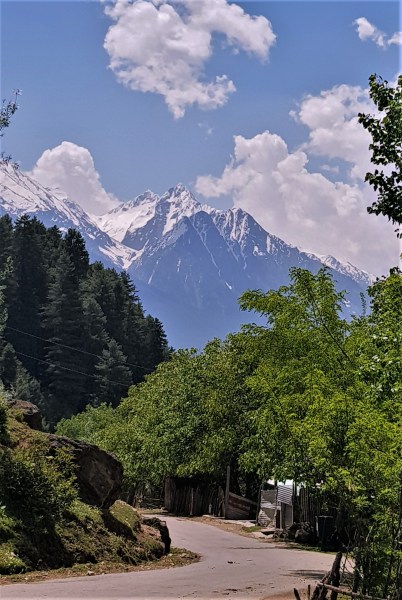 After tasty idli, sambar, coconut chutney (made from dried coconut since we are now far from palm tree country), and the local morning bread called lavasa, we drove up toward Aru. The original plan had been to have tea with a Gujjar family in this stunning area high in the Himalayas, but the woman we were to meet had gone into labor the night before. We mentally sent her good wishes while stopping to photograph this amazing area with flowing glacial streams, wildflowers, and the ever-present snow-capped mountains. With a few more days in Kashmir, we definitely would have done some amazing trekking. As it was, we reluctantly turned the car back toward Srinigar.
After tasty idli, sambar, coconut chutney (made from dried coconut since we are now far from palm tree country), and the local morning bread called lavasa, we drove up toward Aru. The original plan had been to have tea with a Gujjar family in this stunning area high in the Himalayas, but the woman we were to meet had gone into labor the night before. We mentally sent her good wishes while stopping to photograph this amazing area with flowing glacial streams, wildflowers, and the ever-present snow-capped mountains. With a few more days in Kashmir, we definitely would have done some amazing trekking. As it was, we reluctantly turned the car back toward Srinigar. with a roof. We journeyed across the lake and ended up at the beautiful
with a roof. We journeyed across the lake and ended up at the beautiful 




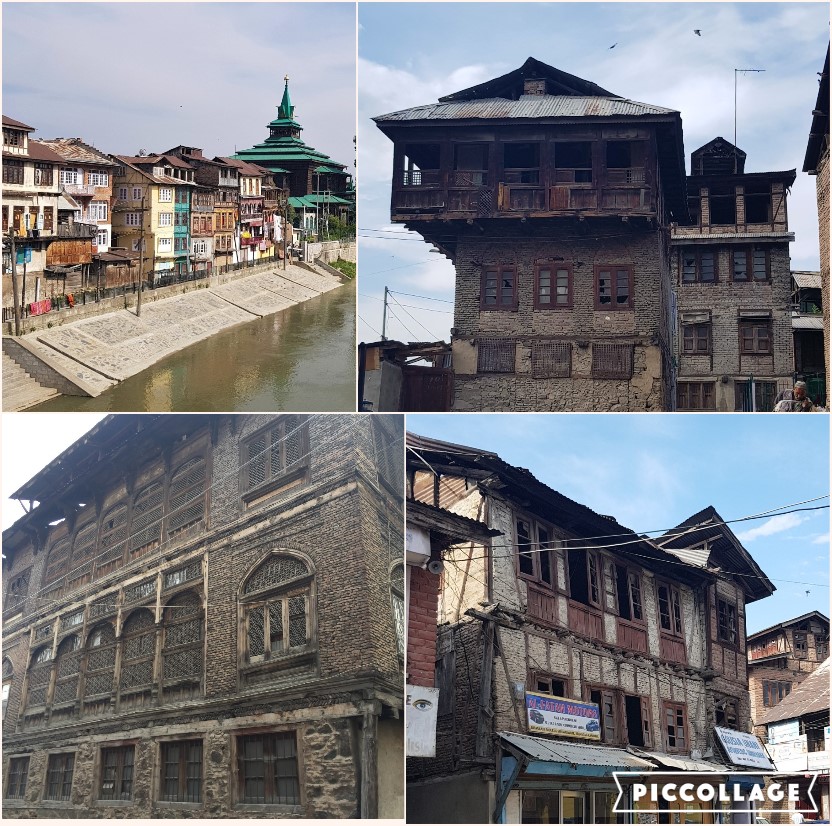


 carving intricate patterns into walnut and pine, making chests, stair railings, and table tops among other things. We couldn’t resist a big carved mortar and pestle. Now we’re
carving intricate patterns into walnut and pine, making chests, stair railings, and table tops among other things. We couldn’t resist a big carved mortar and pestle. Now we’re 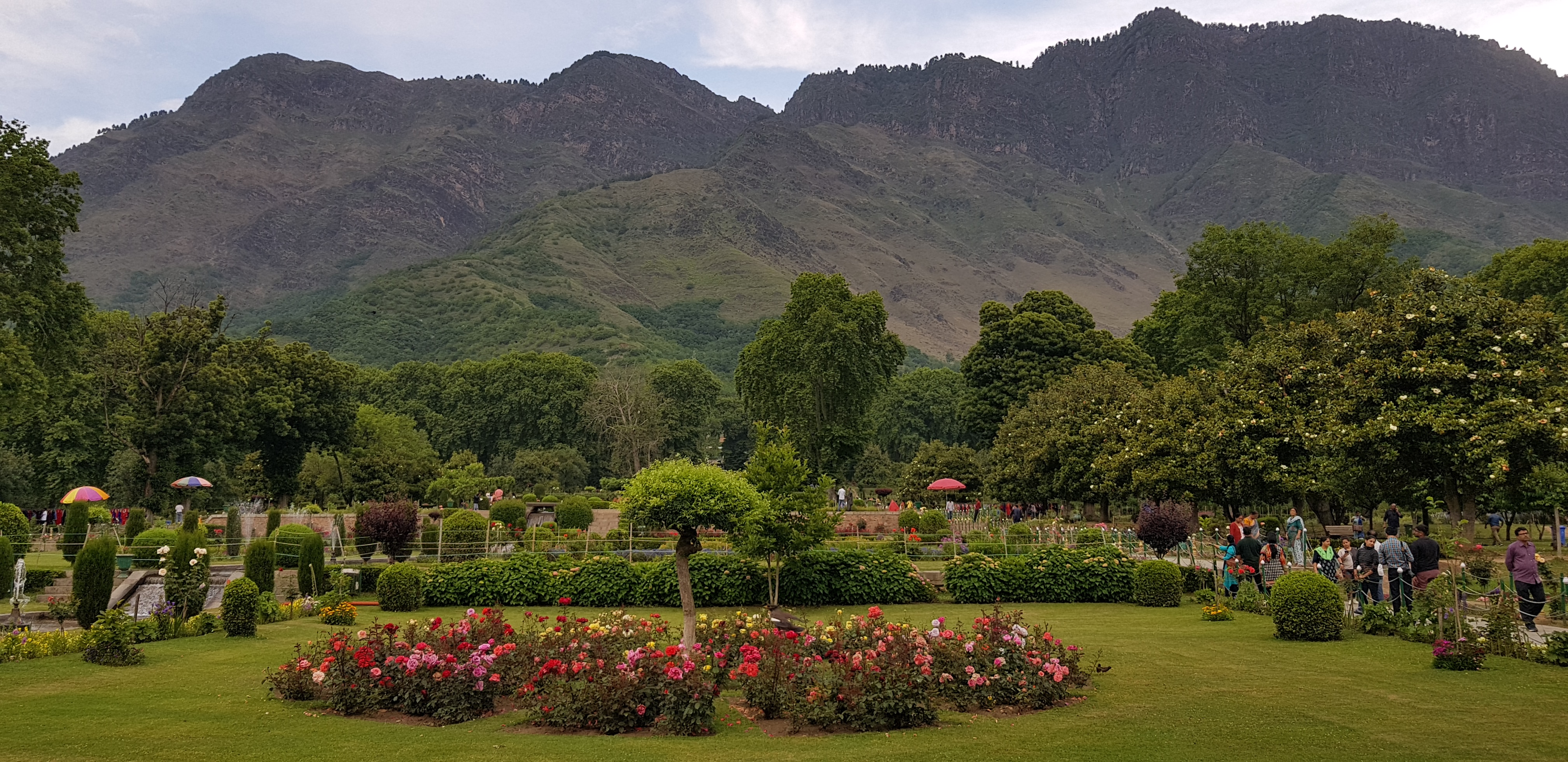
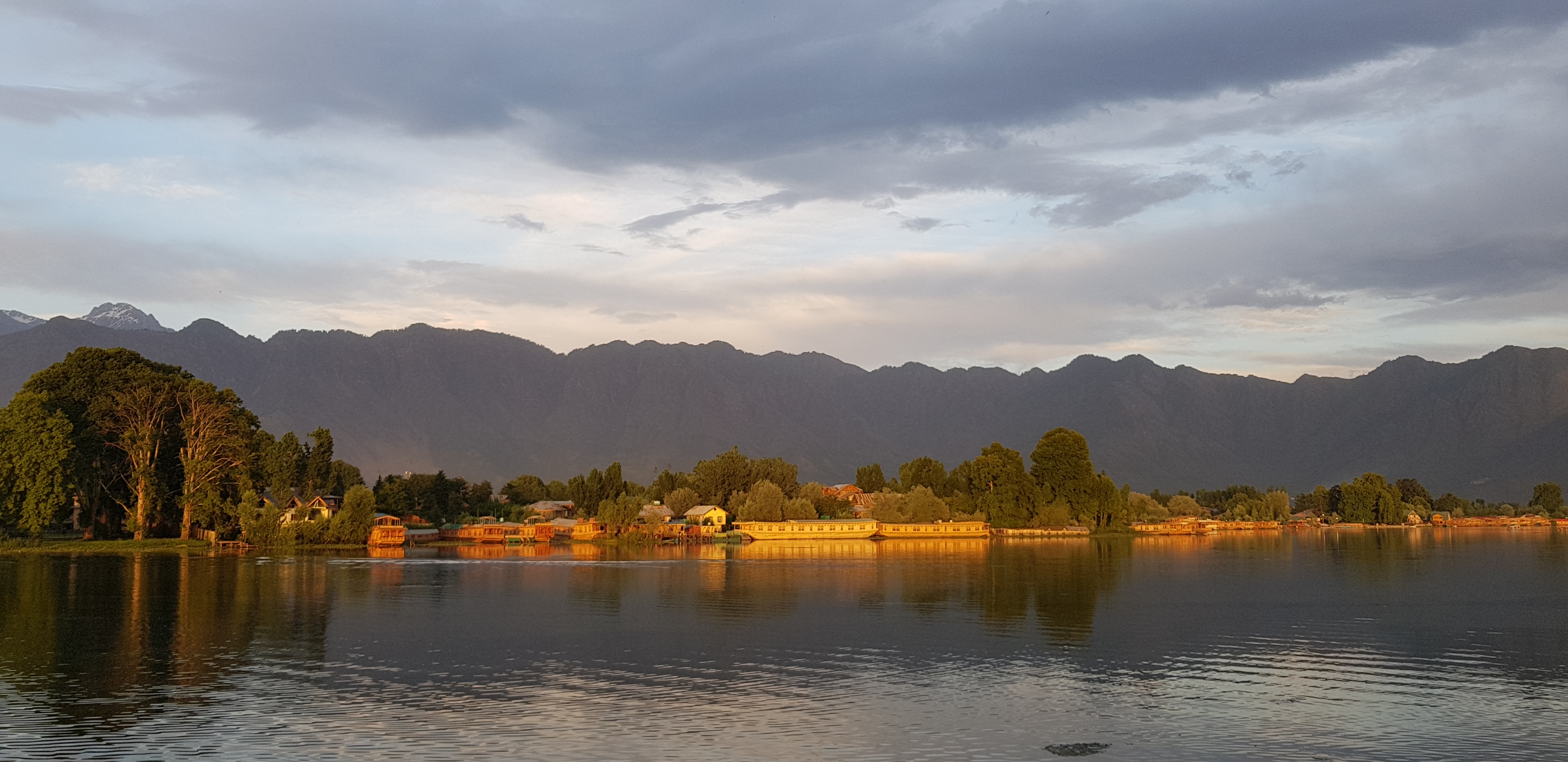
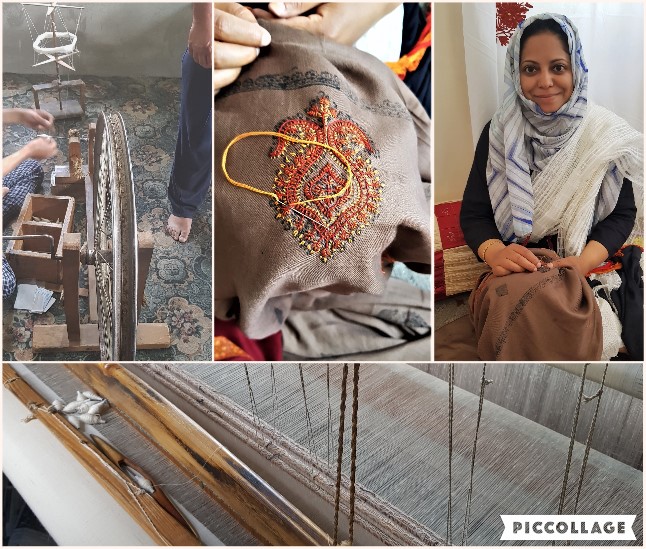
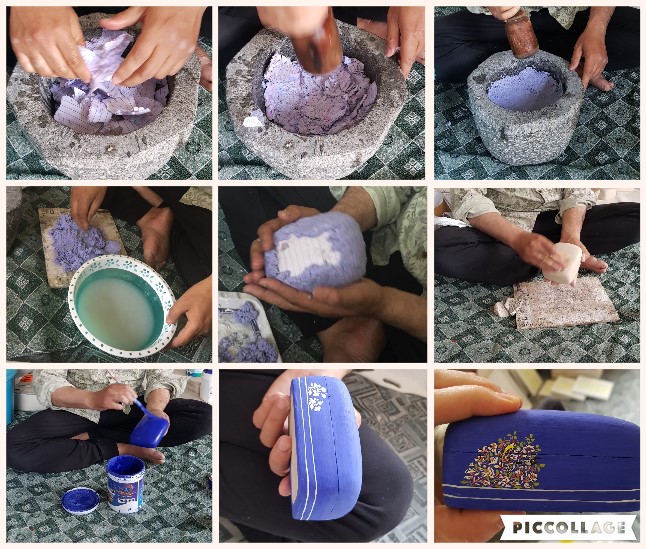
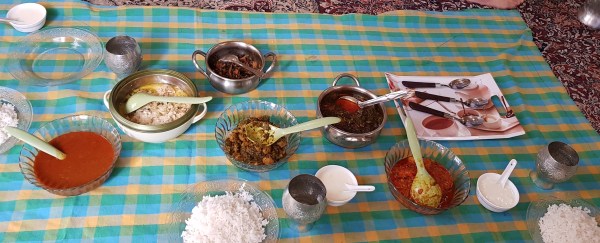 lunch, seated on the floor in their dining room with food arranged on a cloth on the floor. Everything was delicious and it was a pleasure to sit with the family. Some of them joined us even though they were fasting, but a couple of the men were eating because of health conditions. After lunch, we were taken to a room where we could see all of Maqbool’s finished products. Wow. Just, wow.
lunch, seated on the floor in their dining room with food arranged on a cloth on the floor. Everything was delicious and it was a pleasure to sit with the family. Some of them joined us even though they were fasting, but a couple of the men were eating because of health conditions. After lunch, we were taken to a room where we could see all of Maqbool’s finished products. Wow. Just, wow.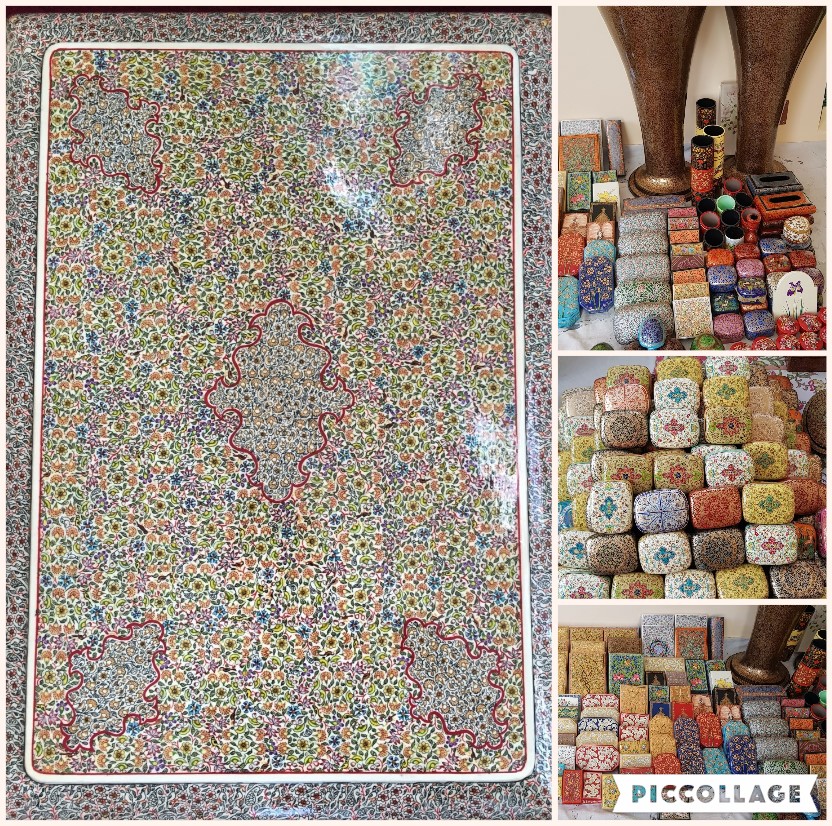
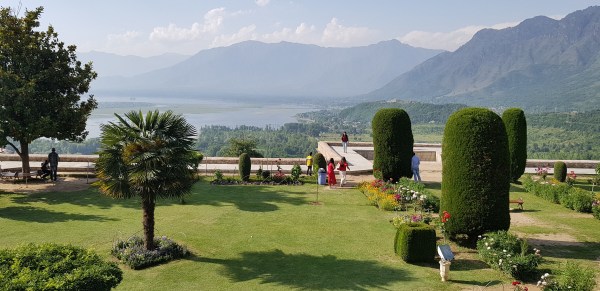 stunning Mughal garden. This one is high in the hills with a very steep terrace and strong retaining walls that are almost fortress-like. Each of the seven levels has a different feeling, all of them beautiful. We finished the day at a tea house where the walls are covered with a mural painted by Maqbool Jan. There we sampled Noon Chai, a popular salty tea in Kashmir to which you add crushed, dried corn. We enjoyed it more when we thought of it as soup.
stunning Mughal garden. This one is high in the hills with a very steep terrace and strong retaining walls that are almost fortress-like. Each of the seven levels has a different feeling, all of them beautiful. We finished the day at a tea house where the walls are covered with a mural painted by Maqbool Jan. There we sampled Noon Chai, a popular salty tea in Kashmir to which you add crushed, dried corn. We enjoyed it more when we thought of it as soup.

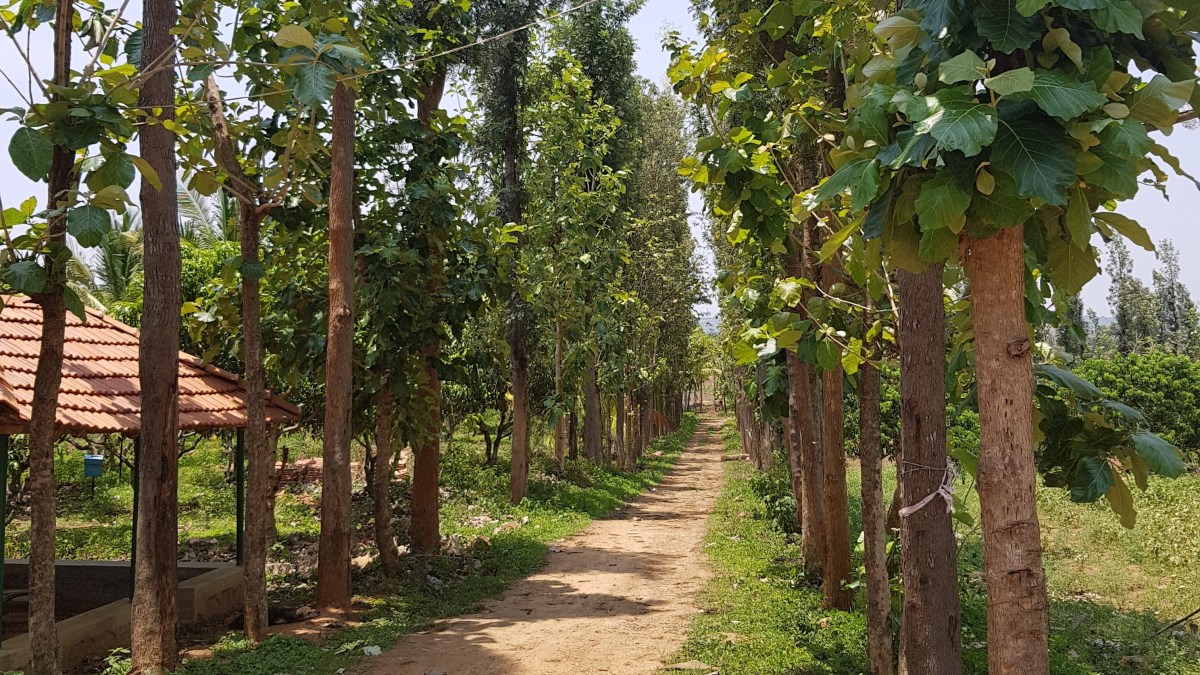
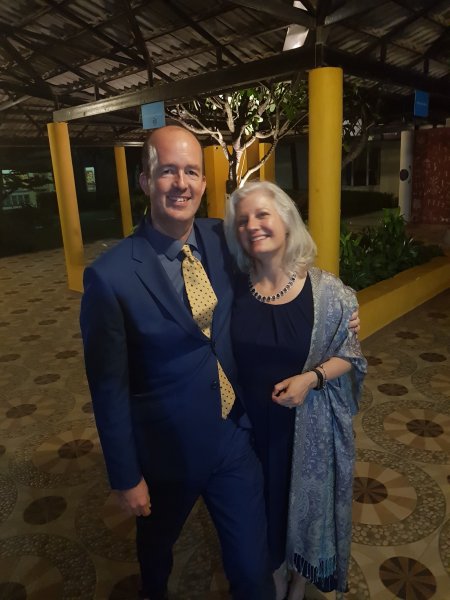 in his new custom suit and Melissa in her Sri Lankan jewelry, and go to celebrate kids that Tom has taught for two years. The ceremony itself was relatively short and quite lovely with a notable address by a very accomplished 2014 graduate who came from Canada to talk to the graduates about important things like kindness and gratitude. Plans for dinner under the stars were altered for rain (which one can expect nearly every evening at this time of year) so we sat in the cafeteria which was all dressed up with tablecloths and centerpieces.
in his new custom suit and Melissa in her Sri Lankan jewelry, and go to celebrate kids that Tom has taught for two years. The ceremony itself was relatively short and quite lovely with a notable address by a very accomplished 2014 graduate who came from Canada to talk to the graduates about important things like kindness and gratitude. Plans for dinner under the stars were altered for rain (which one can expect nearly every evening at this time of year) so we sat in the cafeteria which was all dressed up with tablecloths and centerpieces. the Leela Palace to use after we move out of our apartment was not going to serve us since it can only be used on a weekend. Realizing that this was our last free Saturday night, Tom quickly called the hotel and got us a reservation for that evening. After our visit to the farm, we went home, hastily packed an overnight bag, and went straight to the Leela where we were upgraded to the exact room that we’d stayed in for
the Leela Palace to use after we move out of our apartment was not going to serve us since it can only be used on a weekend. Realizing that this was our last free Saturday night, Tom quickly called the hotel and got us a reservation for that evening. After our visit to the farm, we went home, hastily packed an overnight bag, and went straight to the Leela where we were upgraded to the exact room that we’d stayed in for